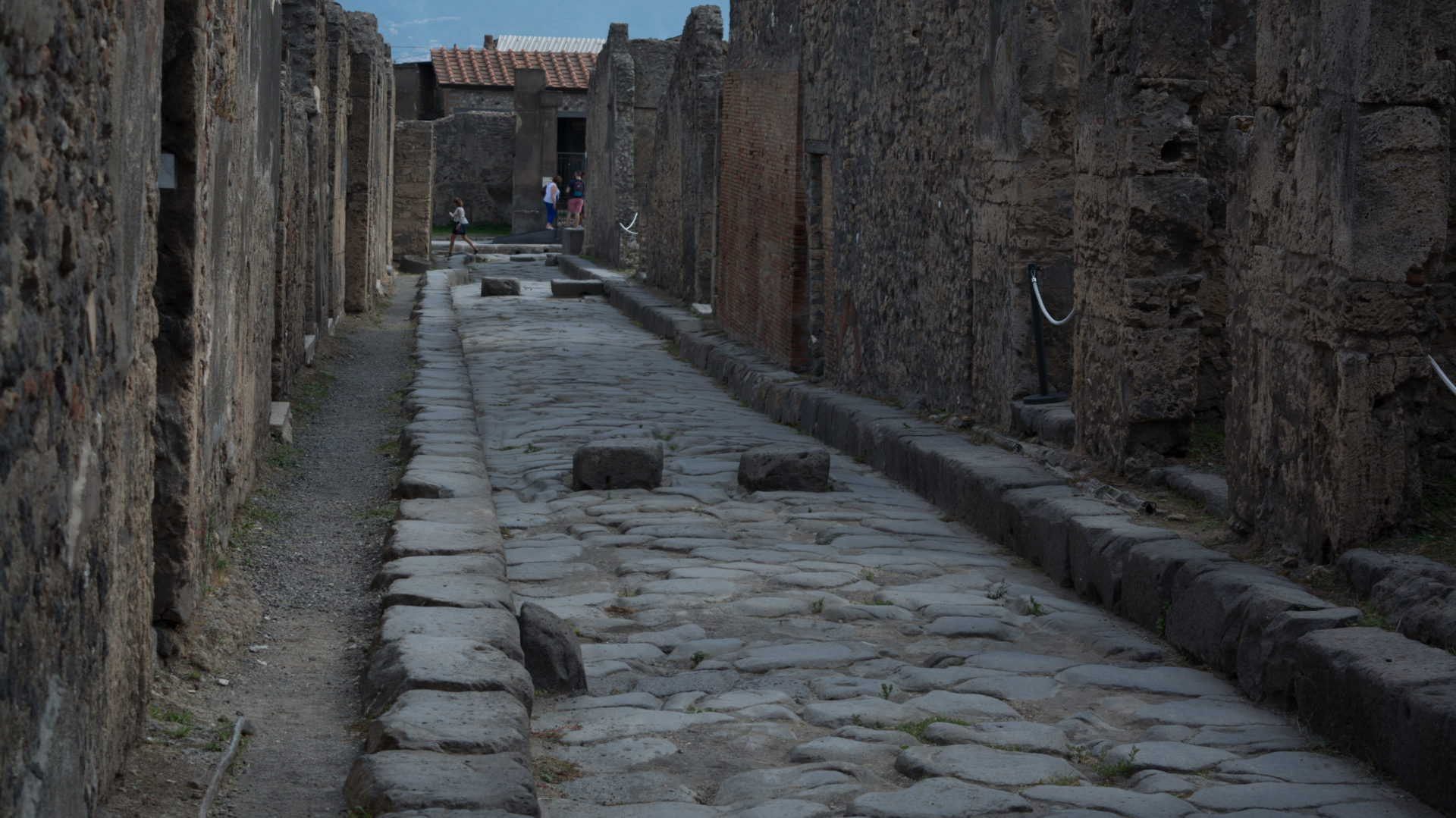On Day 3 we spent the entire day exploring the ruins of Pompeii. I have decided to split this blog post into several parts to make it more manageable, since we saw so much!
Since the hotel was close to Pompeii we could afford to sleep a little later than we did on Day 2. I had my alarm set for 7, but shortly before that the sun came in through the window and gently woke me up. When I opened the shutters, this was the view:
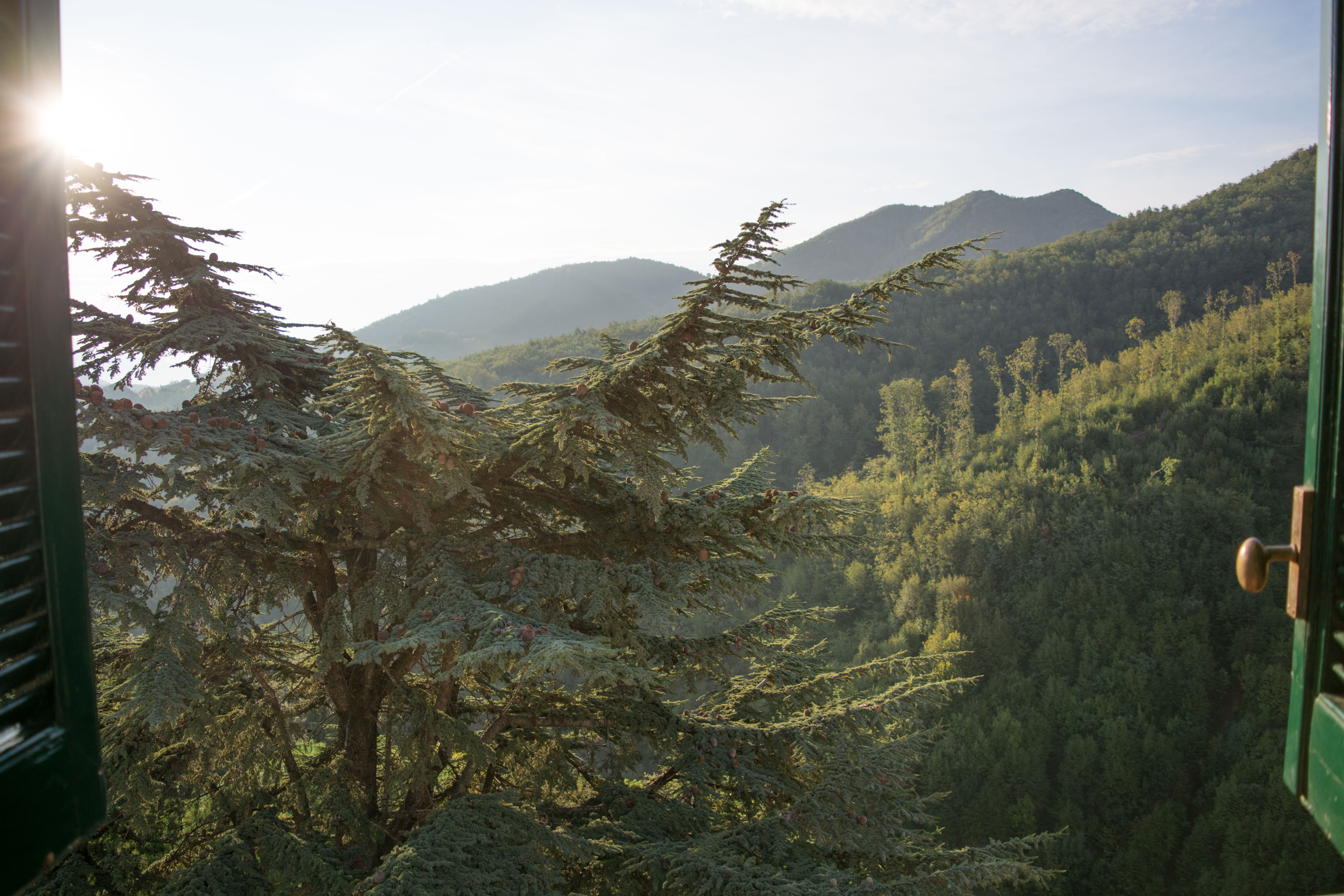
Breakfast was served on a terrace overlooking the mountains. The view from there was magnificent:
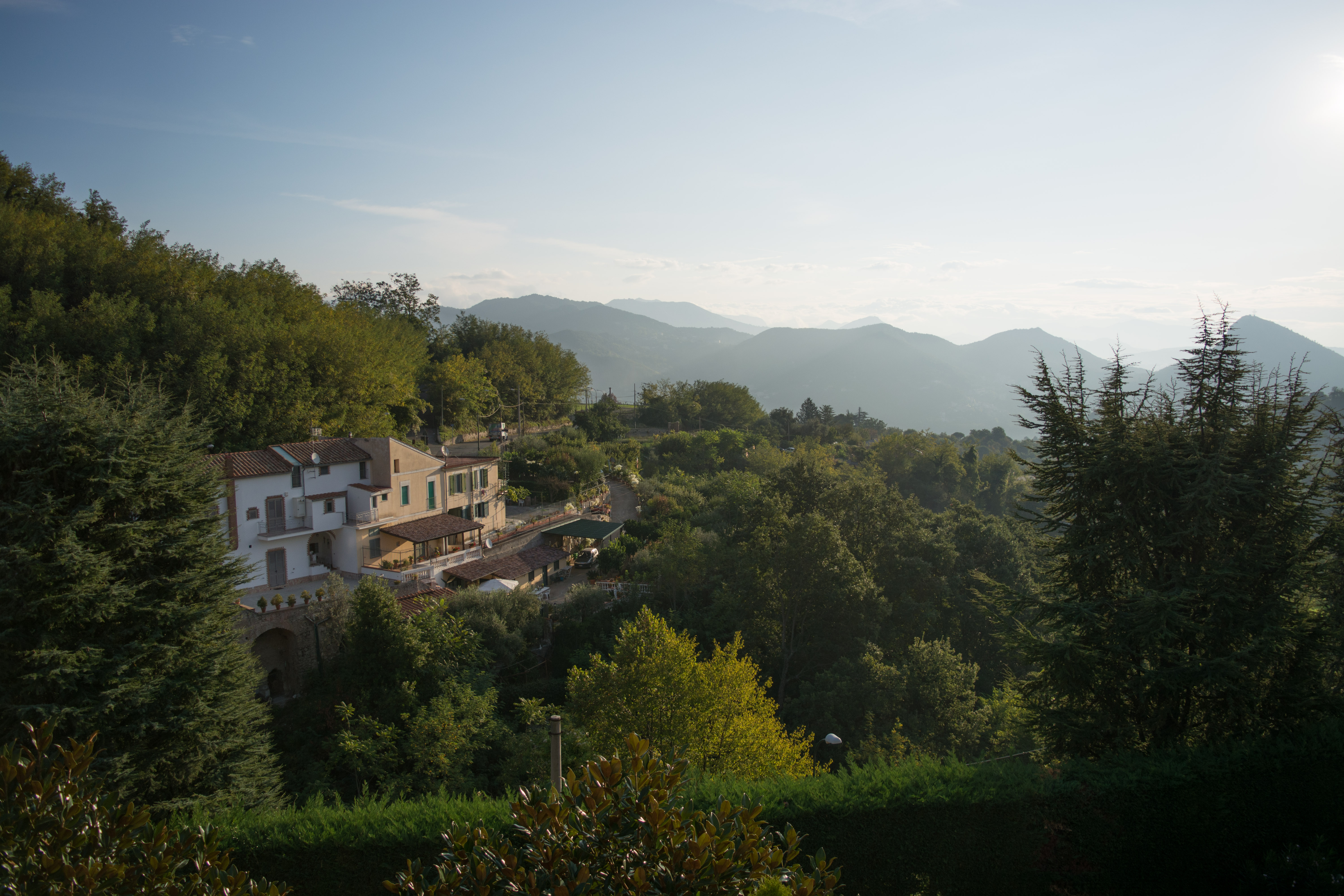
The Italians eat light for breakfast, so typically we would be served an assortment of pastries and cold meat, with some coffee or espresso:
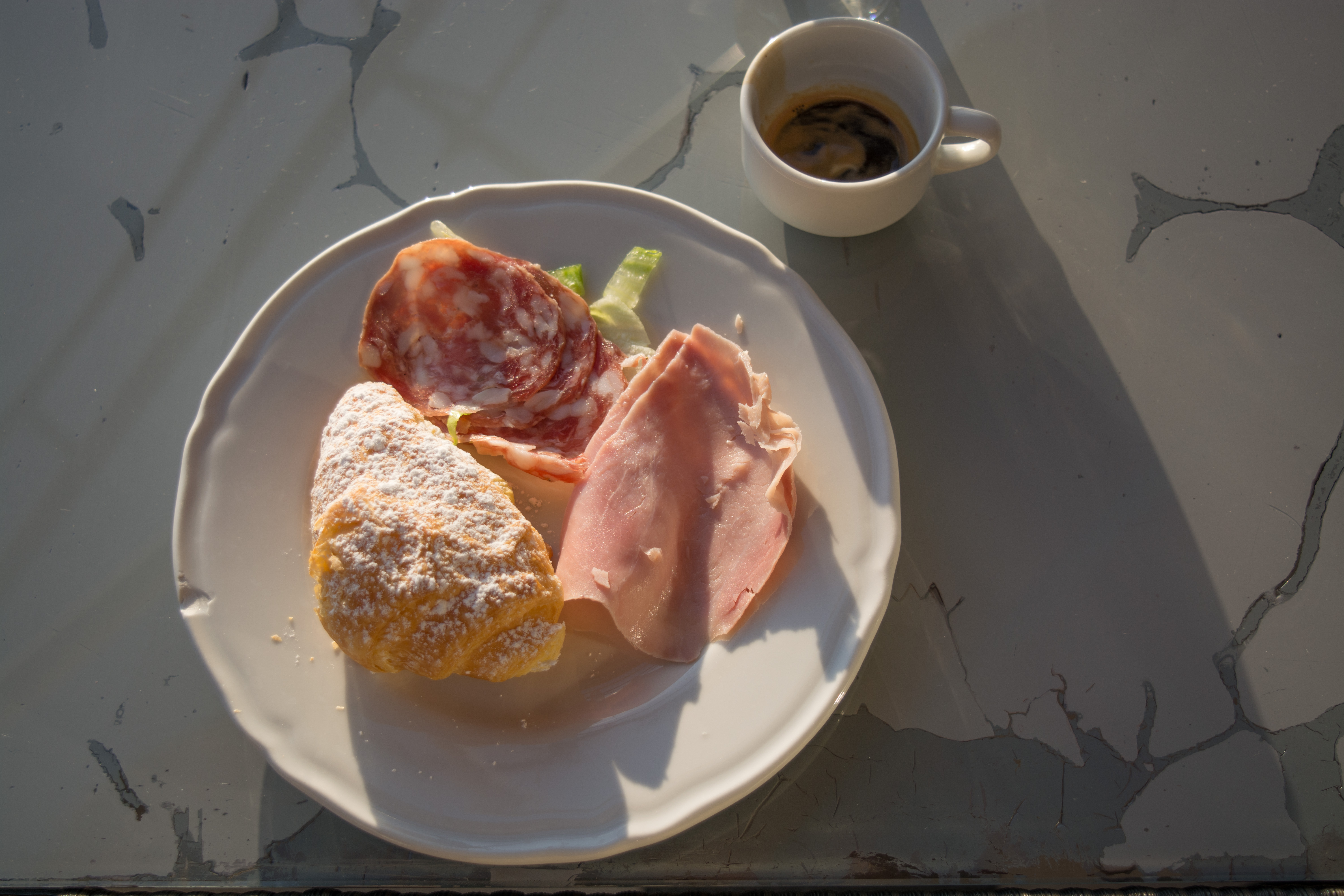
The hotel was built into an old Aragonese fortress on the side of the mountain, and I snapped this picture of part of the old castle as I walked by. The coat of arms lists the date as 1496:
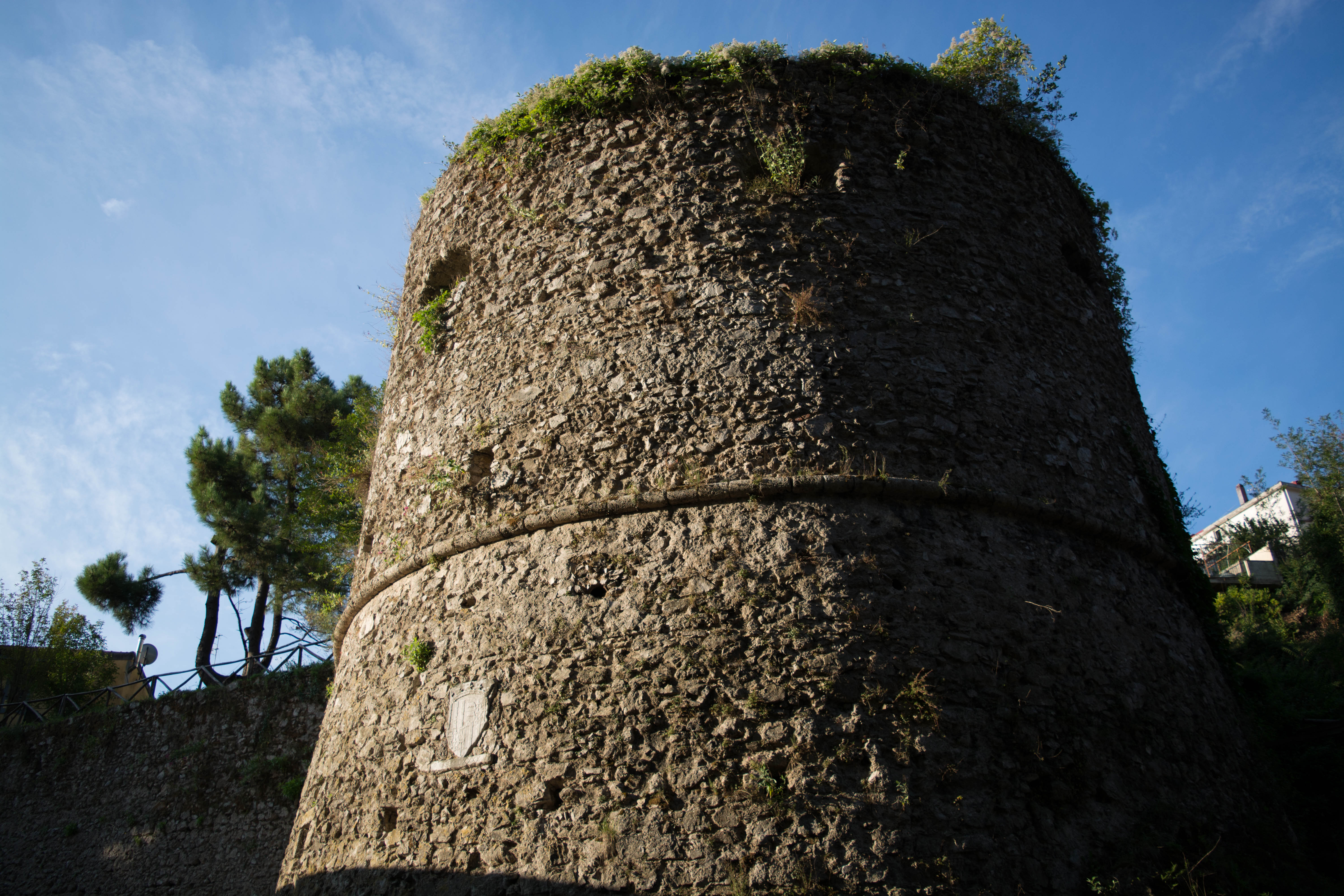
The drive to Pompeii was short, and we arrived at the Amphitheater gate (on the Southeast corner) just before it opened. Inside the gate, before you enter the ruins, there are two glass buildings containing the plaster casts of some of the people who died in the eruption. After the bodies were buried by the ash they rotted away, leaving a void behind. When archaeologists excavated the site they filled these voids with plaster, producing a cast of the body that had been there before. The white plaster casts are one of the things that Pompeii is famous for. Out of respect for the dead, I have decided not to publish any photographs of the casts. But when we looked at them we could see that several had bones sticking out of the plaster (the bones had not rotted). Other casts had recognizable clothing on them, including one male with his sleeves rolled up. Some of the casts were lying down, others were curled up. One cast was of a dog whose owner had fled the house in such a hurry that they forgot to let him off the chain. The collar was still visible around his neck, and he appeared to be trying to chew himself loose.
Once inside the gate we first went to a necropolis to see some tombs. The Romans did not like to bury their dead inside the city limits, so tombs are frequently found just outside of a Roman town. One of the tombs was being excavated that morning, and even though I was not allowed to take photos of the dig it was great to see that work is still being done at Pompeii!
We entered the ruins at the Nocera gate:
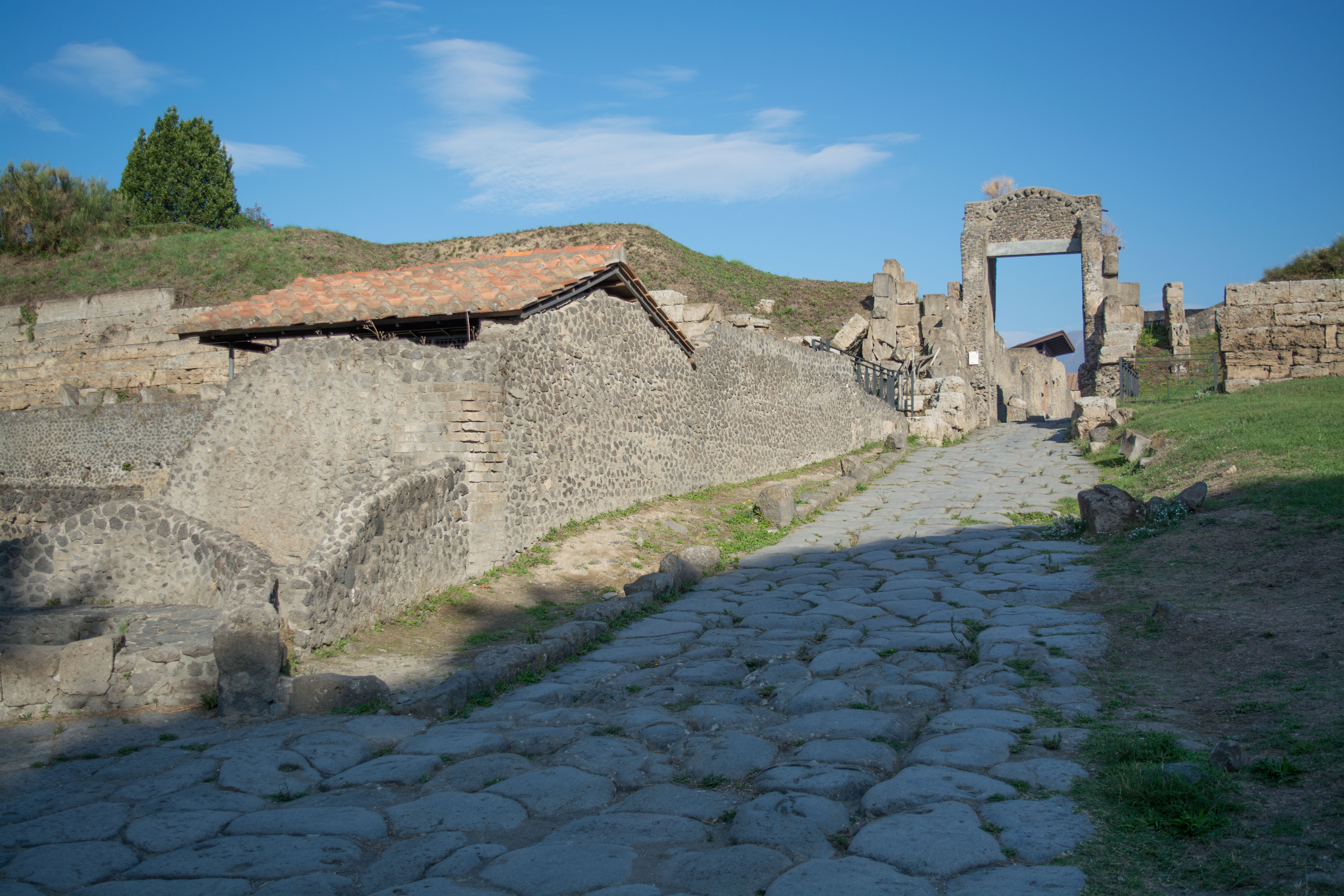
Once we were inside, Tony explained that some parts of the walls and buildings have been restored but much of it is original. To mark out the original parts from the ones that have been restored, these thin red bricks are used to draw a line on the wall:
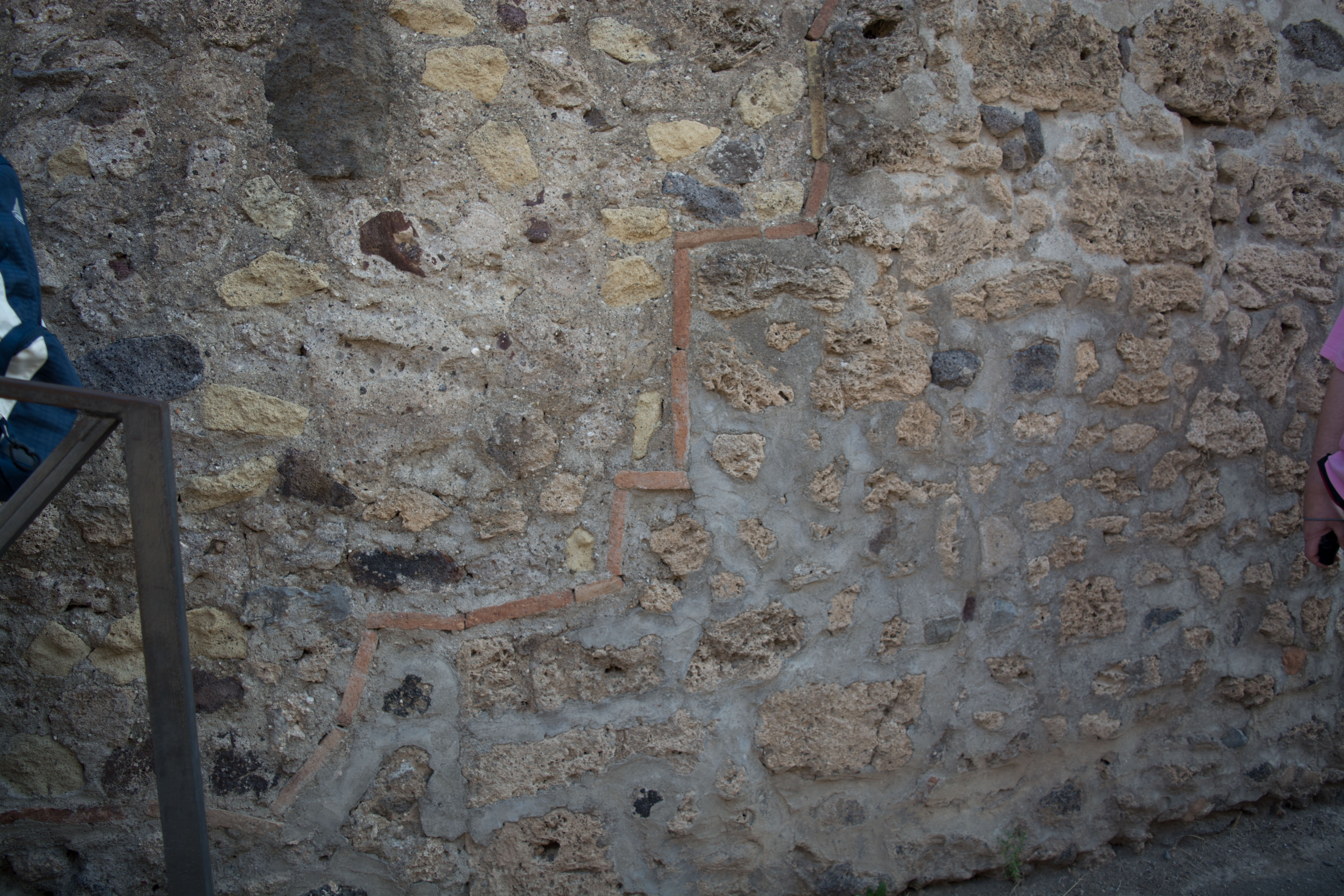
Everything below the line is original, everything above the line is restored.
We also passed a garden nearby, and Tony explained that the same process used to make plaster casts of the bodies was used to make casts of the root systems in Pompeii’s gardens. With the help of botanists these root systems could be identified, and so the archaeologists were able to determine which plants were in each location. Thus the garden you see here has been re-planted with the correct plants in the correct locations, so that it looks exactly the same as it did in 79 AD:
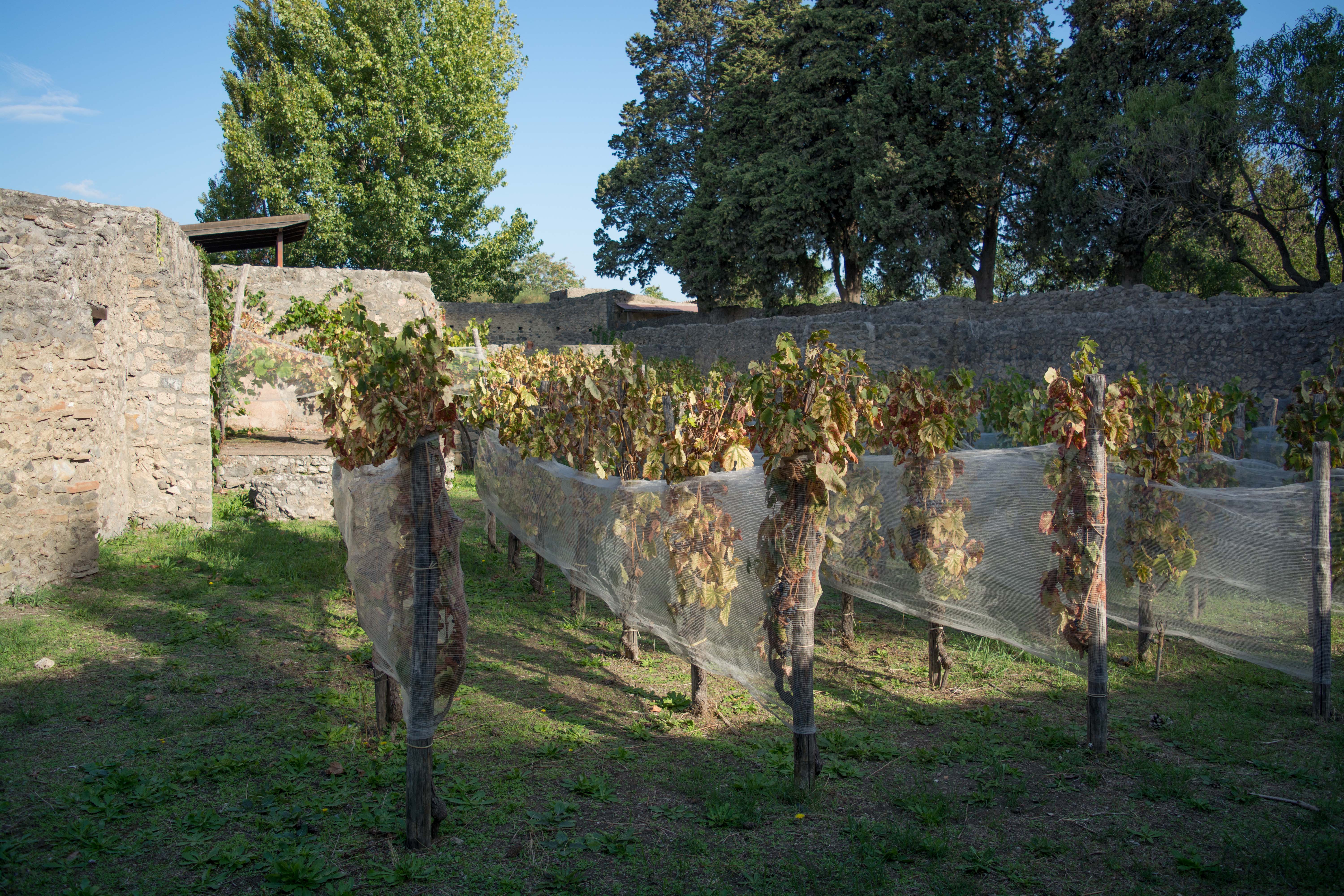
The first large building we came across was the amphitheater, which was completed around 80BC:
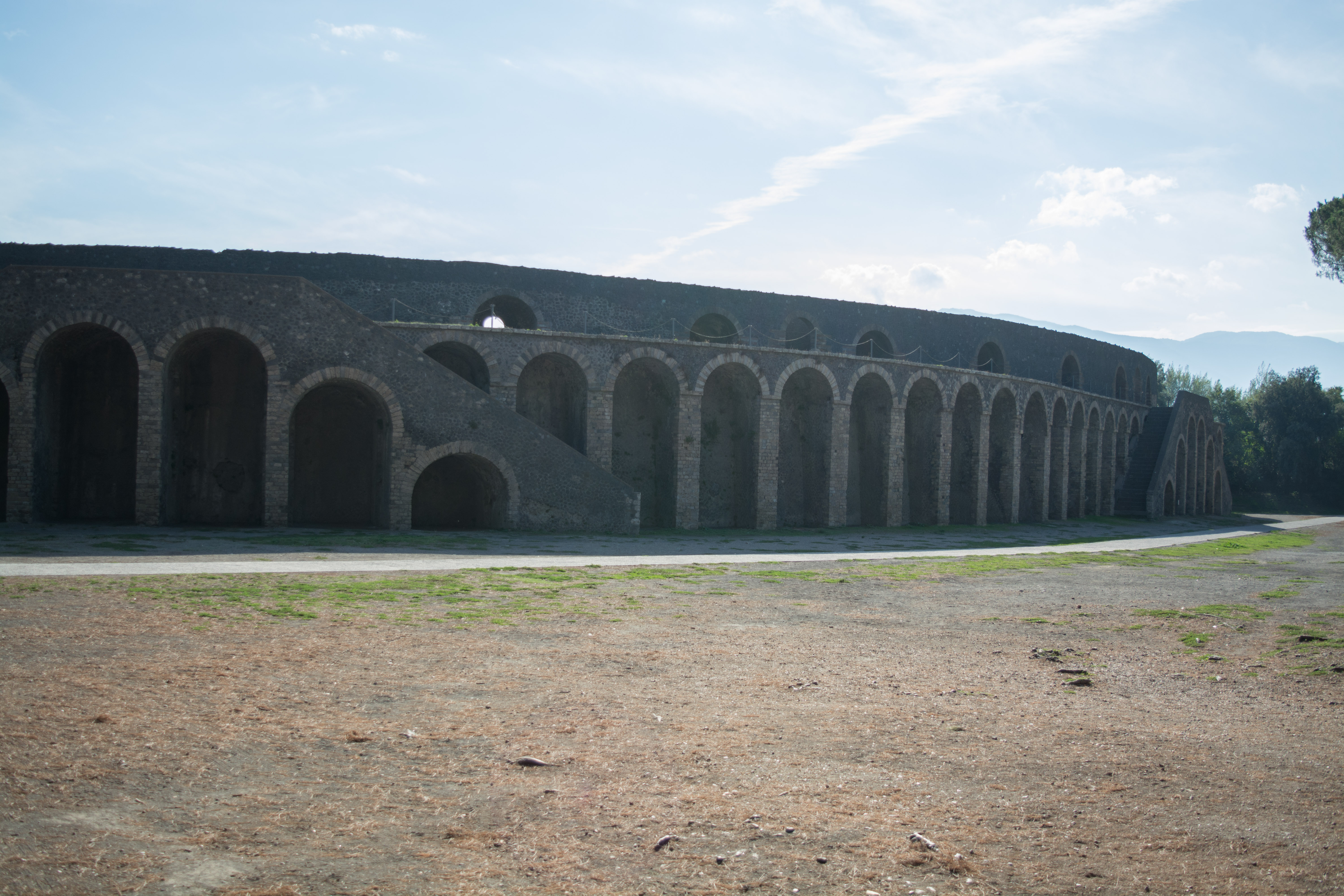
For the most part this amphitheater is exactly as it was found. As you can see from the line of red bricks, only a limited section of the stairway has been restored:

Inside, two tunnels run under the seating. These led to the lower seats and might also have been used for service:
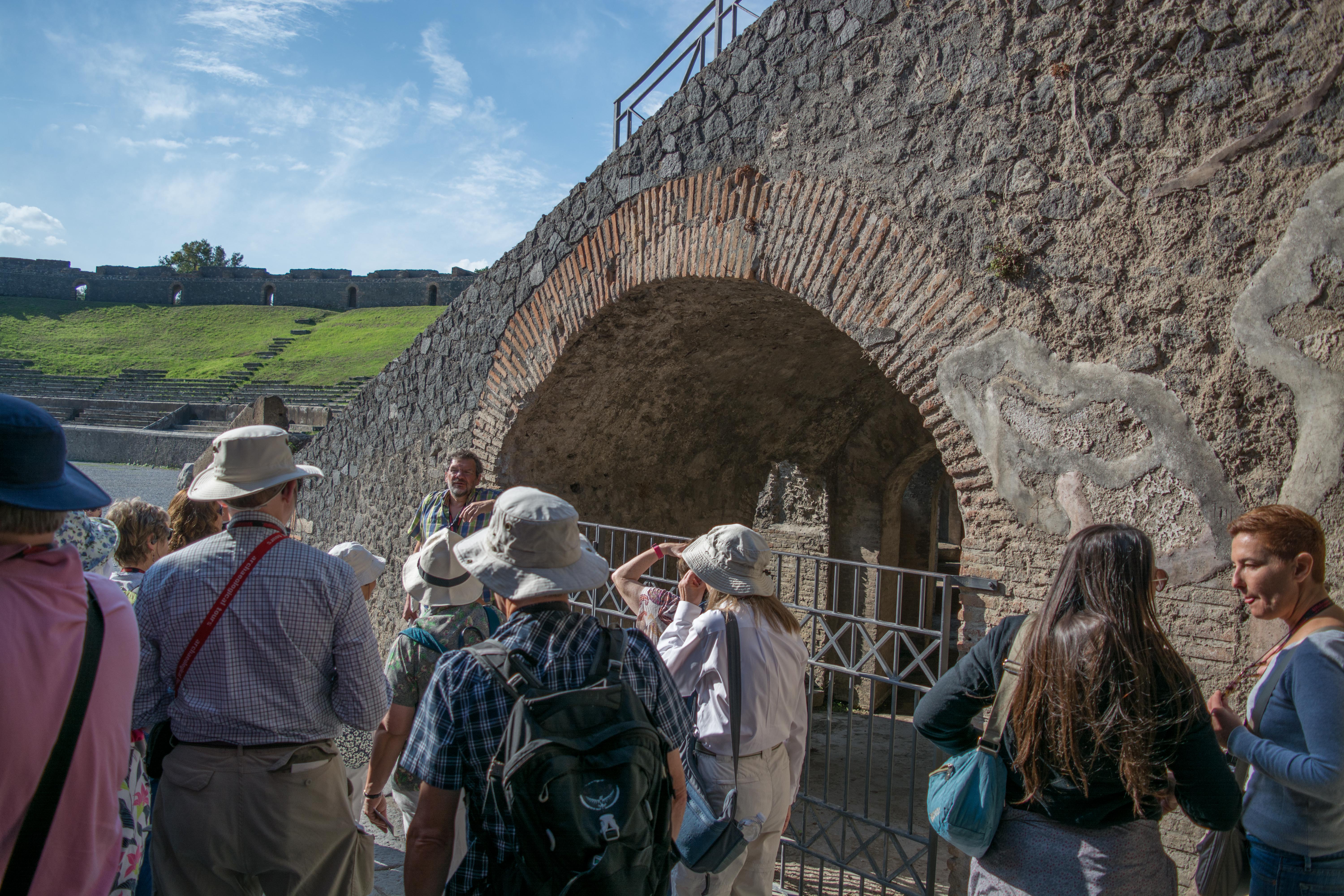
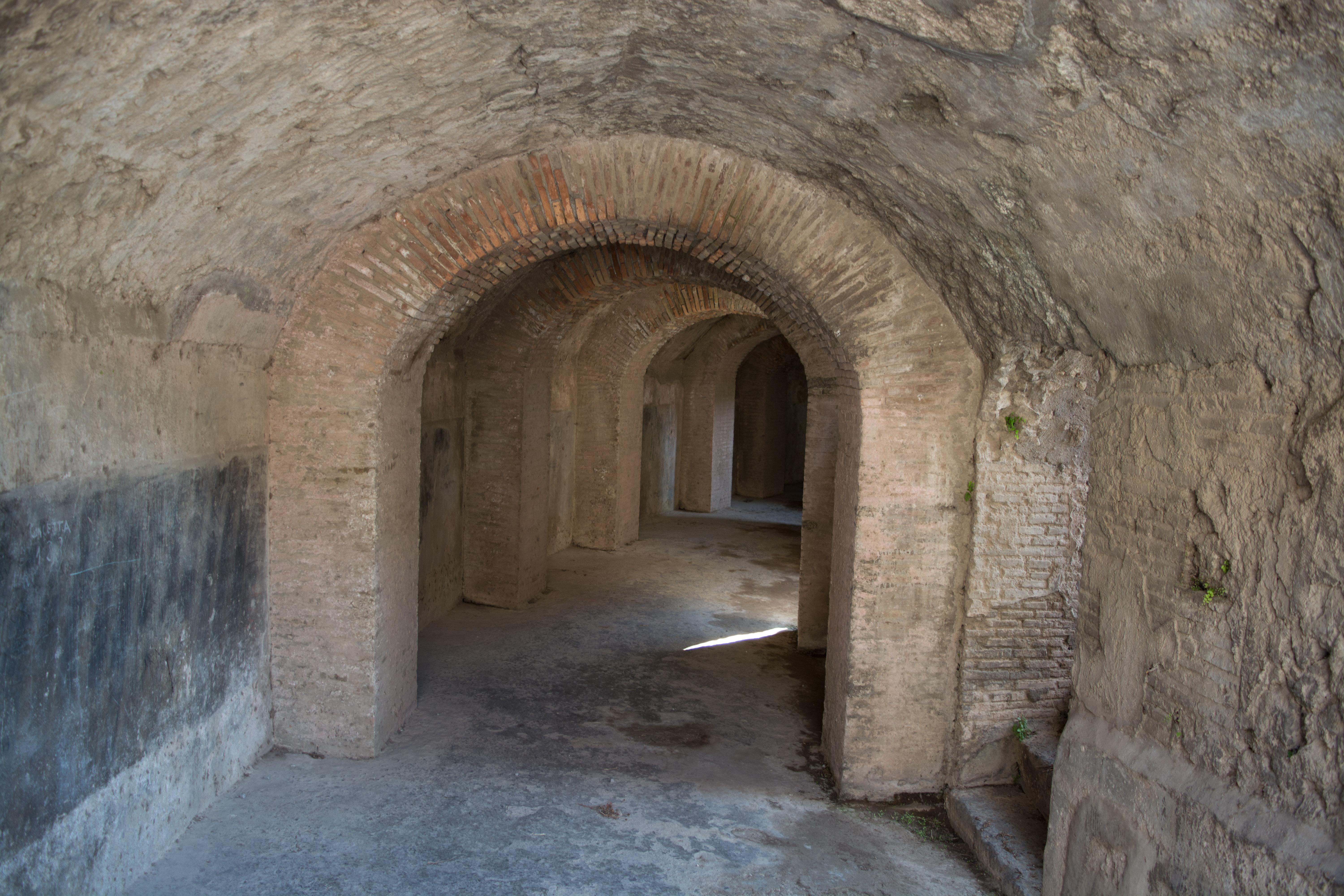
The inside of the amphitheater is very impressive:
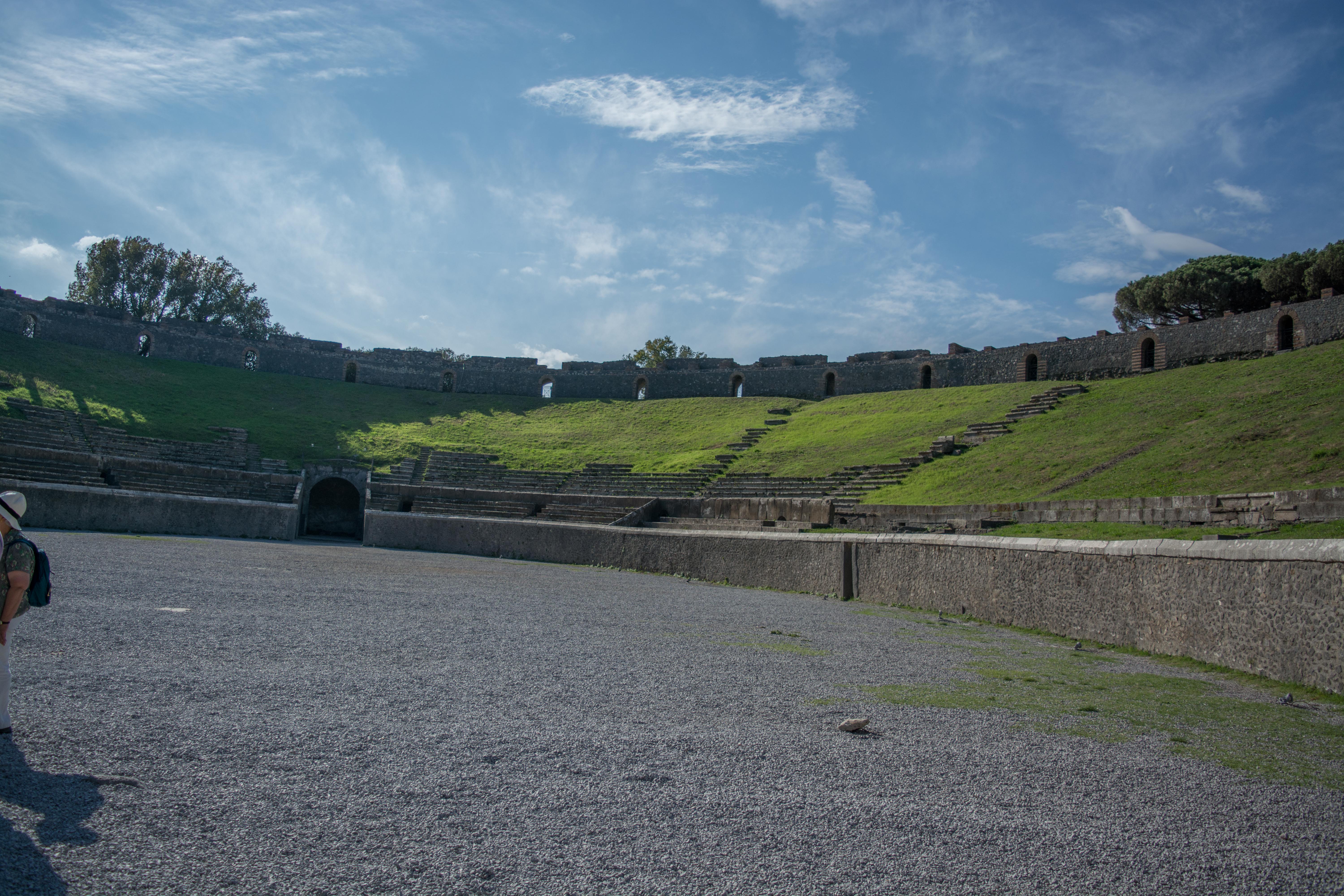
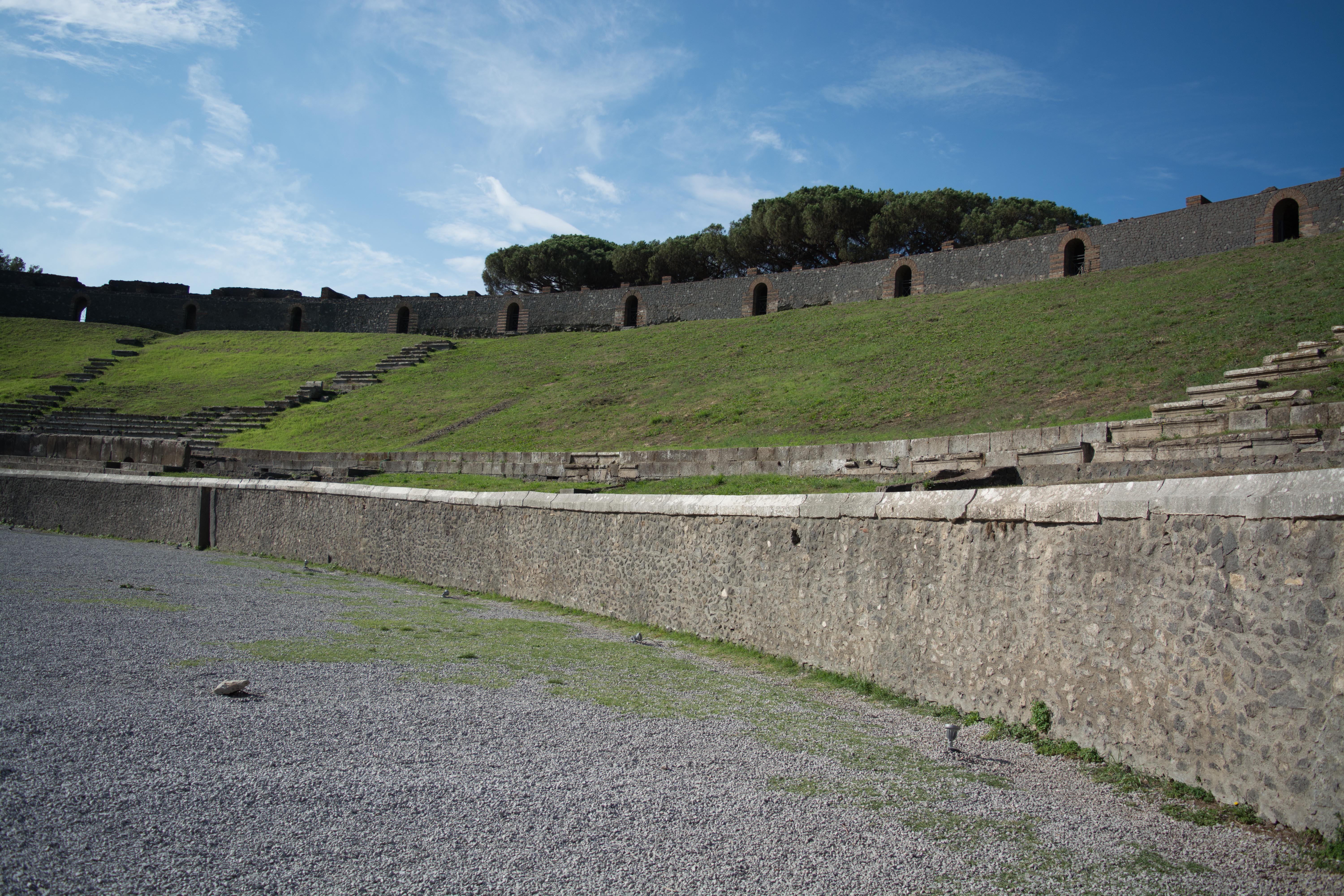
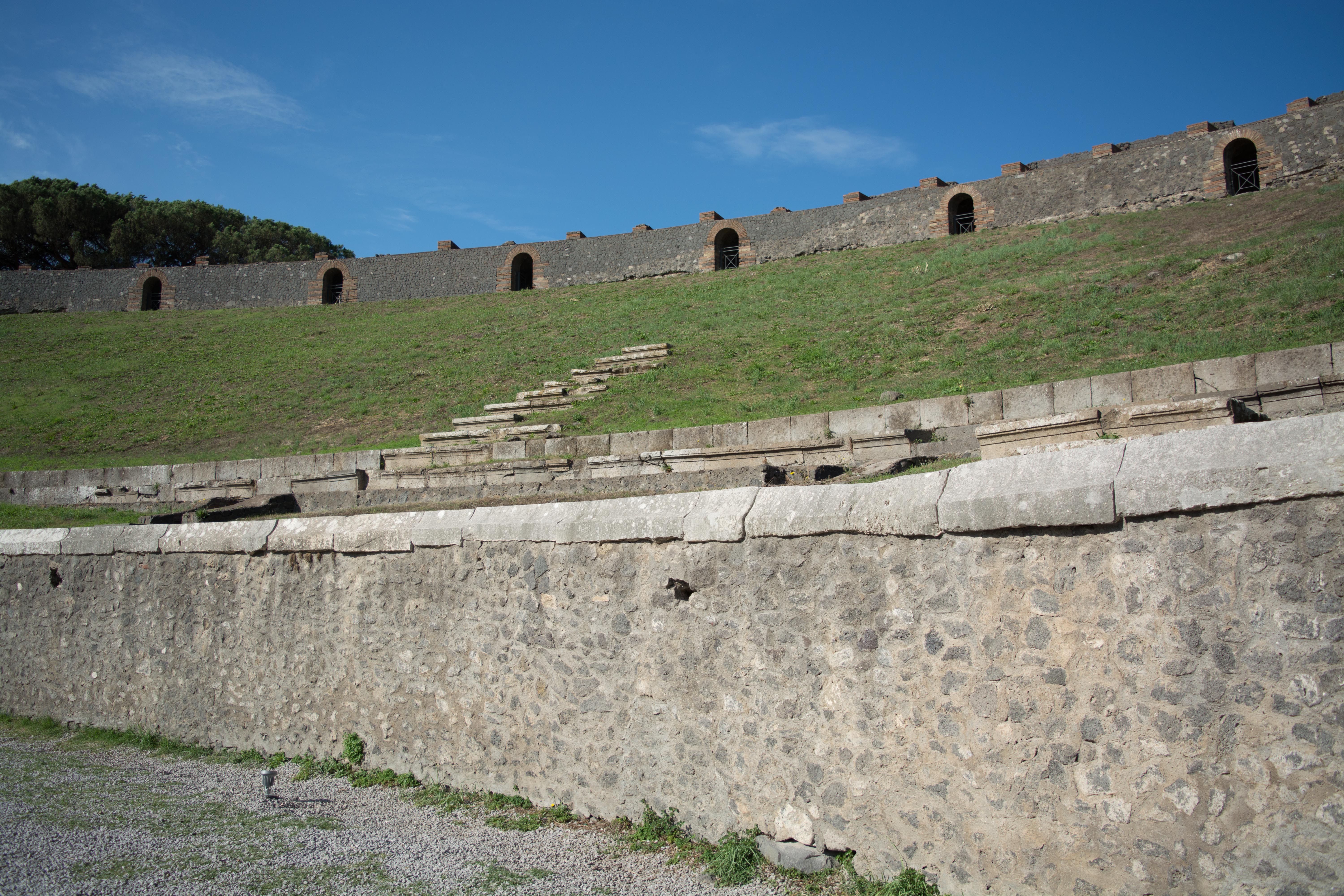
A stone barrier separates the lower seats from the upper ones. The lower seats would have been used by the wealthy, and the upper seats by the poor and middle class. The barrier ensures that no mixing takes place between them. Social status meant everything in the Roman empire:
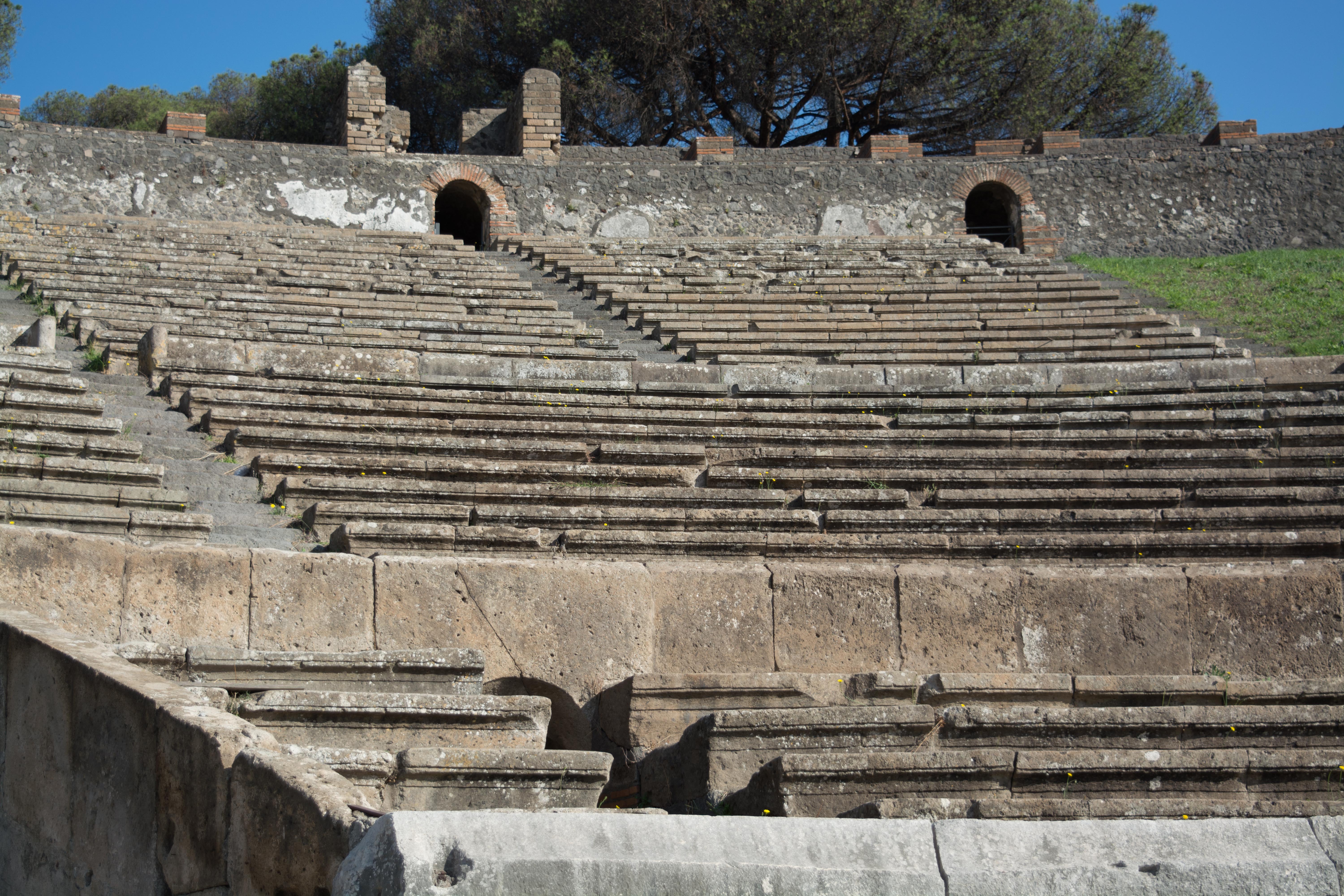
Some of the seats in the front row have names inscribed on them as a way of permanently reserving them for someone. This was sometimes done to honor a wealthy person who made a substantial donation. It could also be done by decree of the city council to honor a particularly distinguished citizen. This particular seat is reserved for someone named Tatullius:
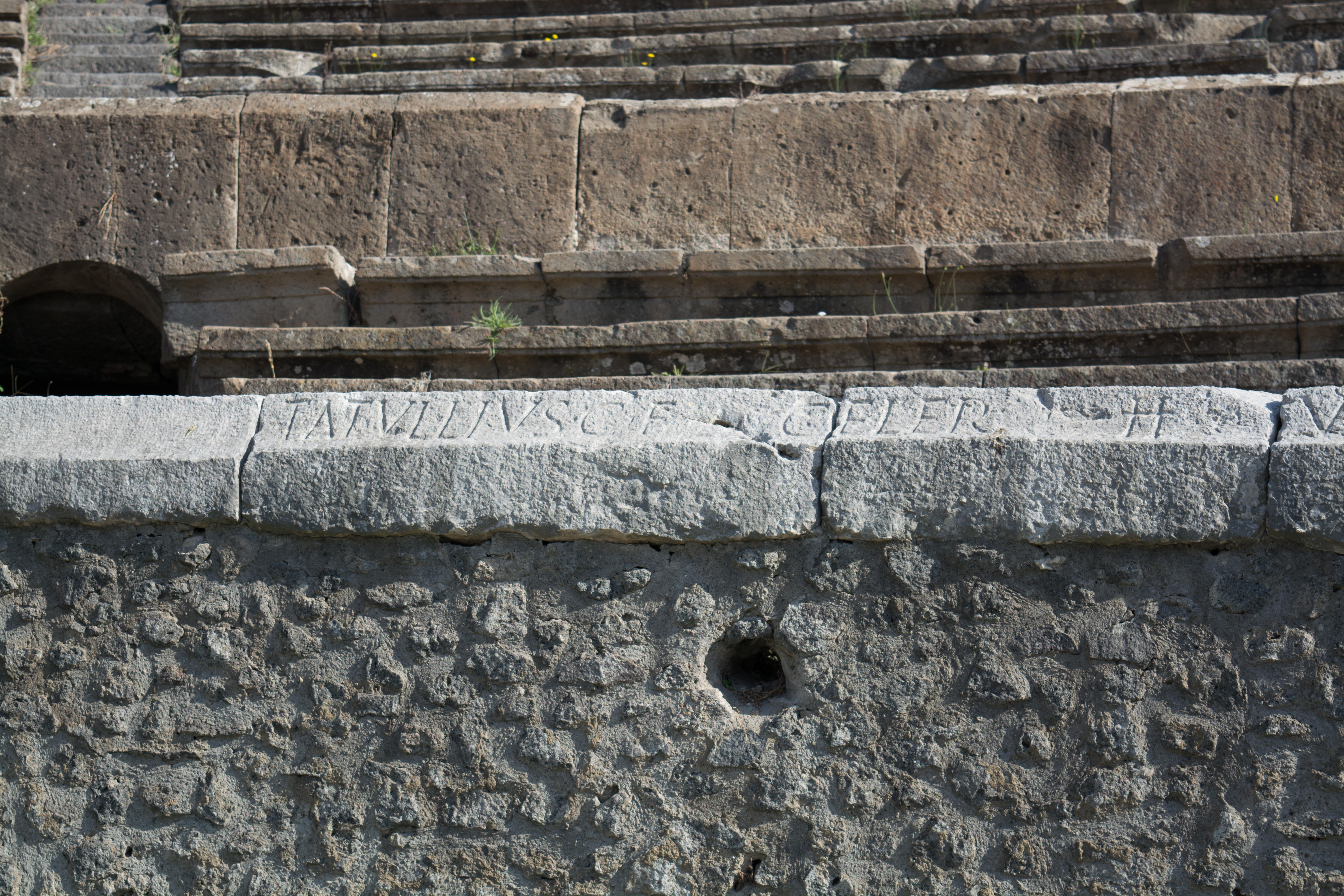
The amphitheater was the site of a riot in the year 59AD, and as a result the Emperor banned all games there for 10 years.
Nearby is an exhibit set up in what used to be a Roman-era fine dining restaurant. On display are some familiar foodstuffs that were carbonized by the eruption in the nearby town of Herculaneum. The tags tell you what they are, but it is hardly needed because even 2,000 years later the food is easily recognizable:
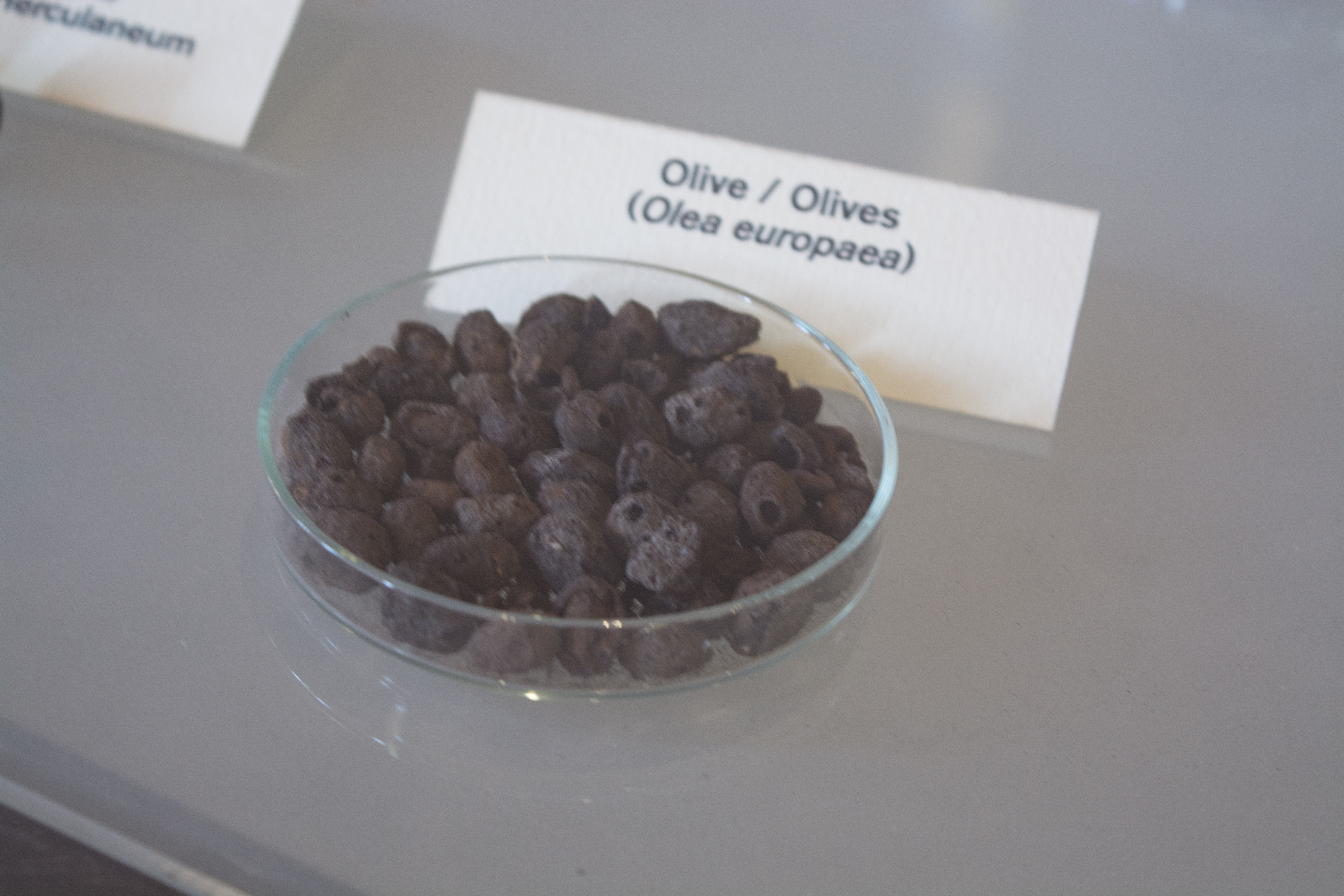
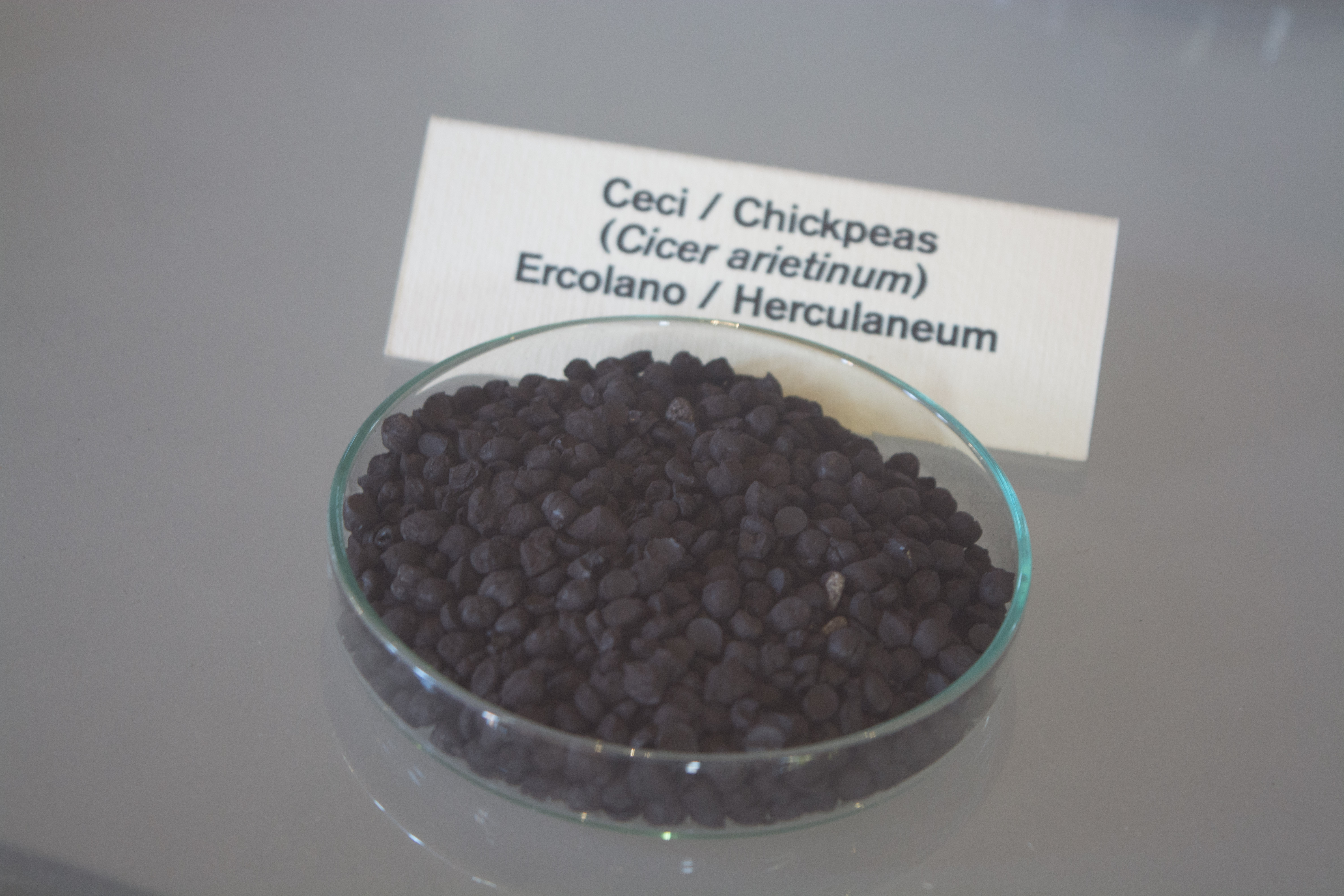
There was also a pine cone and a loaf of bread:
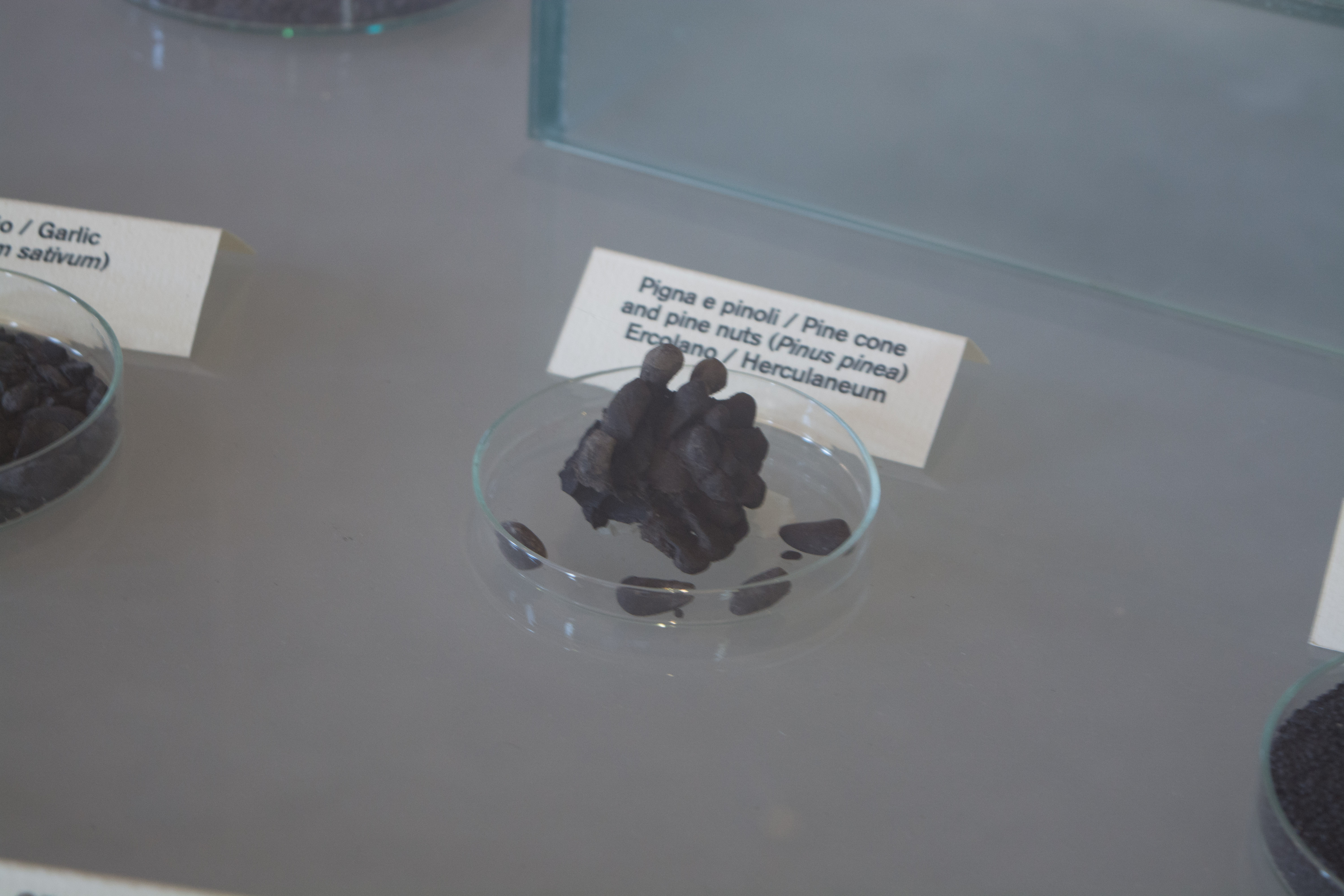
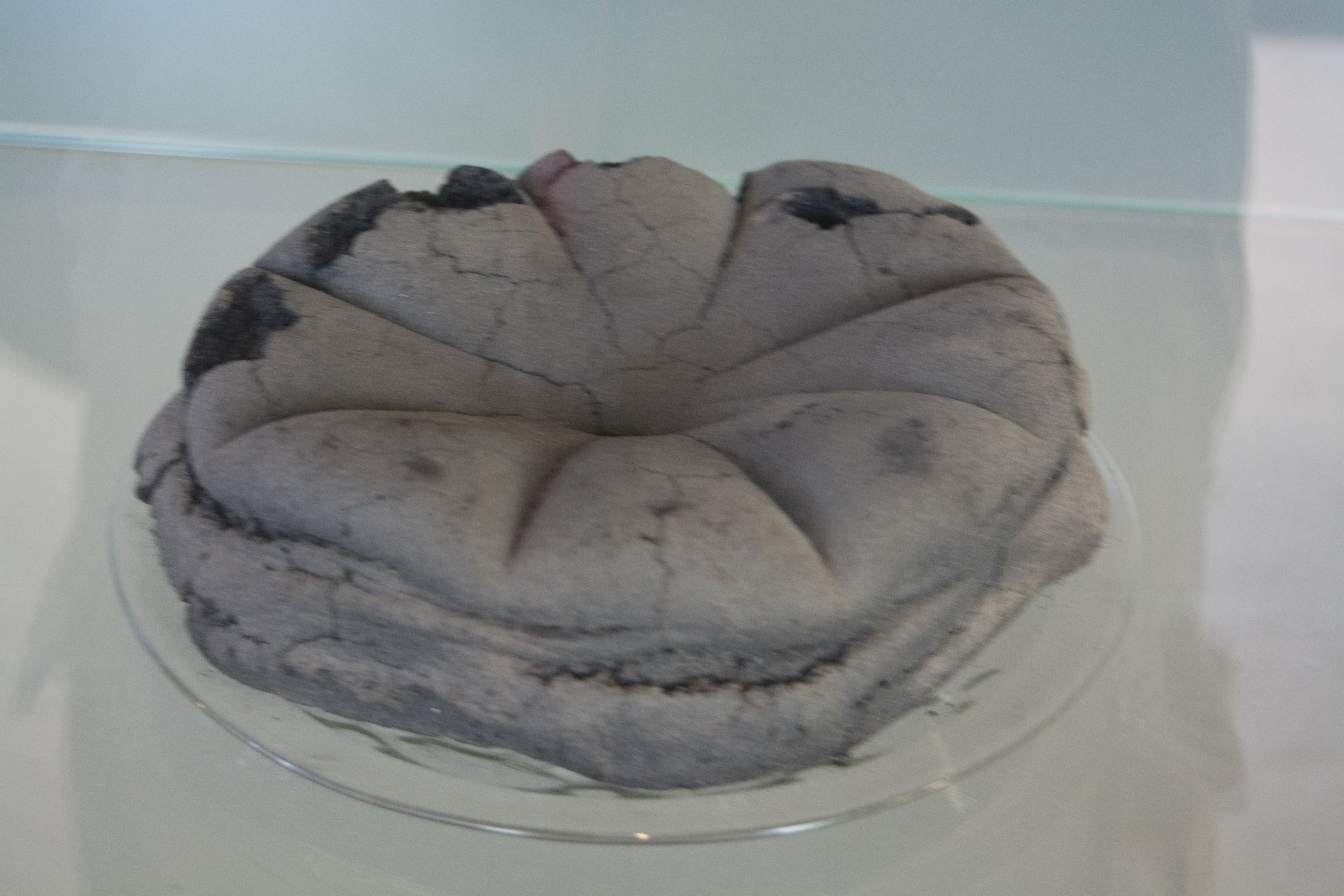
The frescos on the walls of this restaurant are very beautiful and remarkably well preserved:
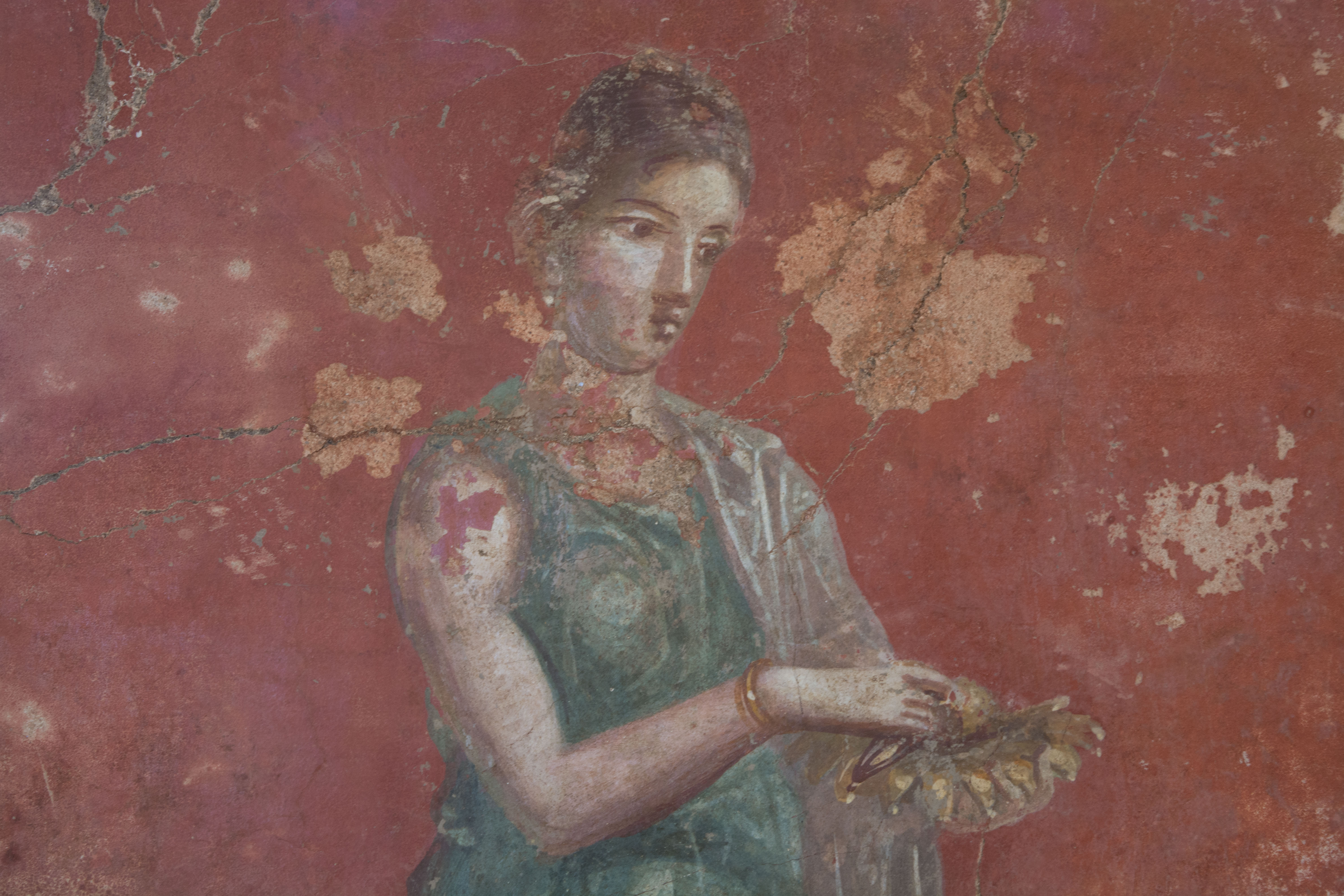
Then we walked down “Abundance Street” to the House of Venus in the Shell. This is one of the more famous houses in Pompeii, and is frequently full of visitors. Like the garden you saw before, this one has been replanted to look exactly as it did in Roman times:
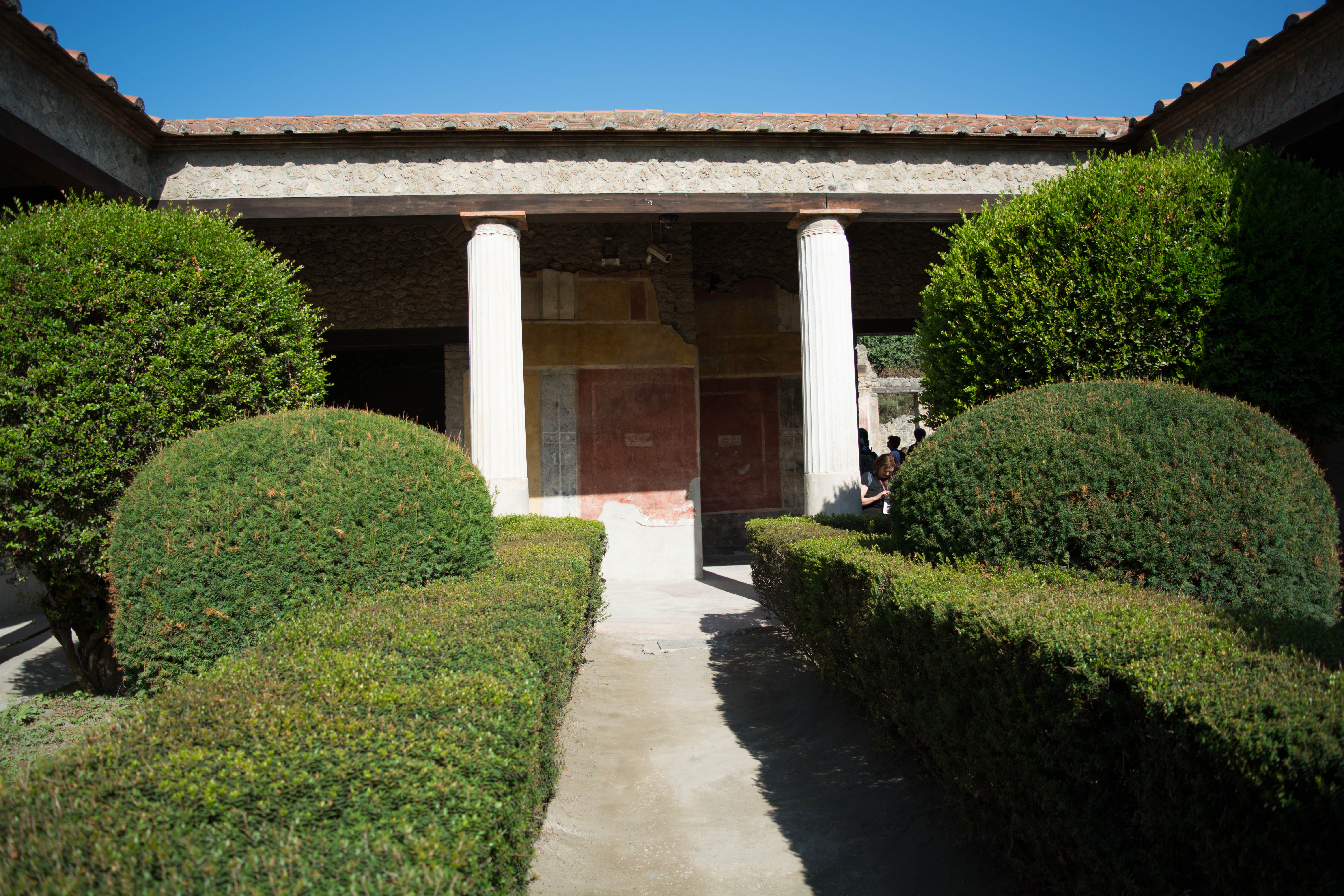
Stretching across one whole wall at the rear of the garden is the famous fresco of Venus in the Shell:
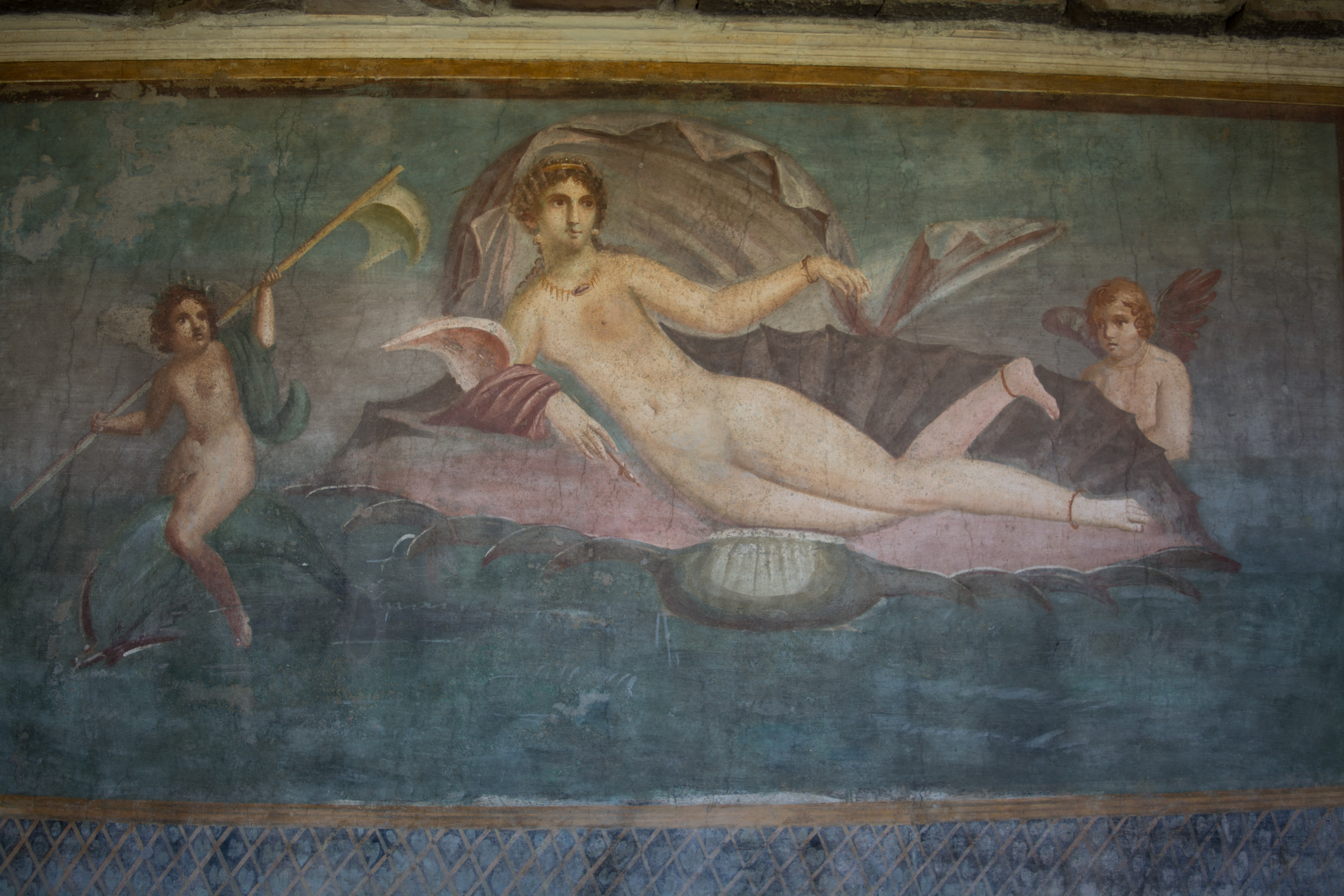
The marble impuvium is also clearly identifiable:
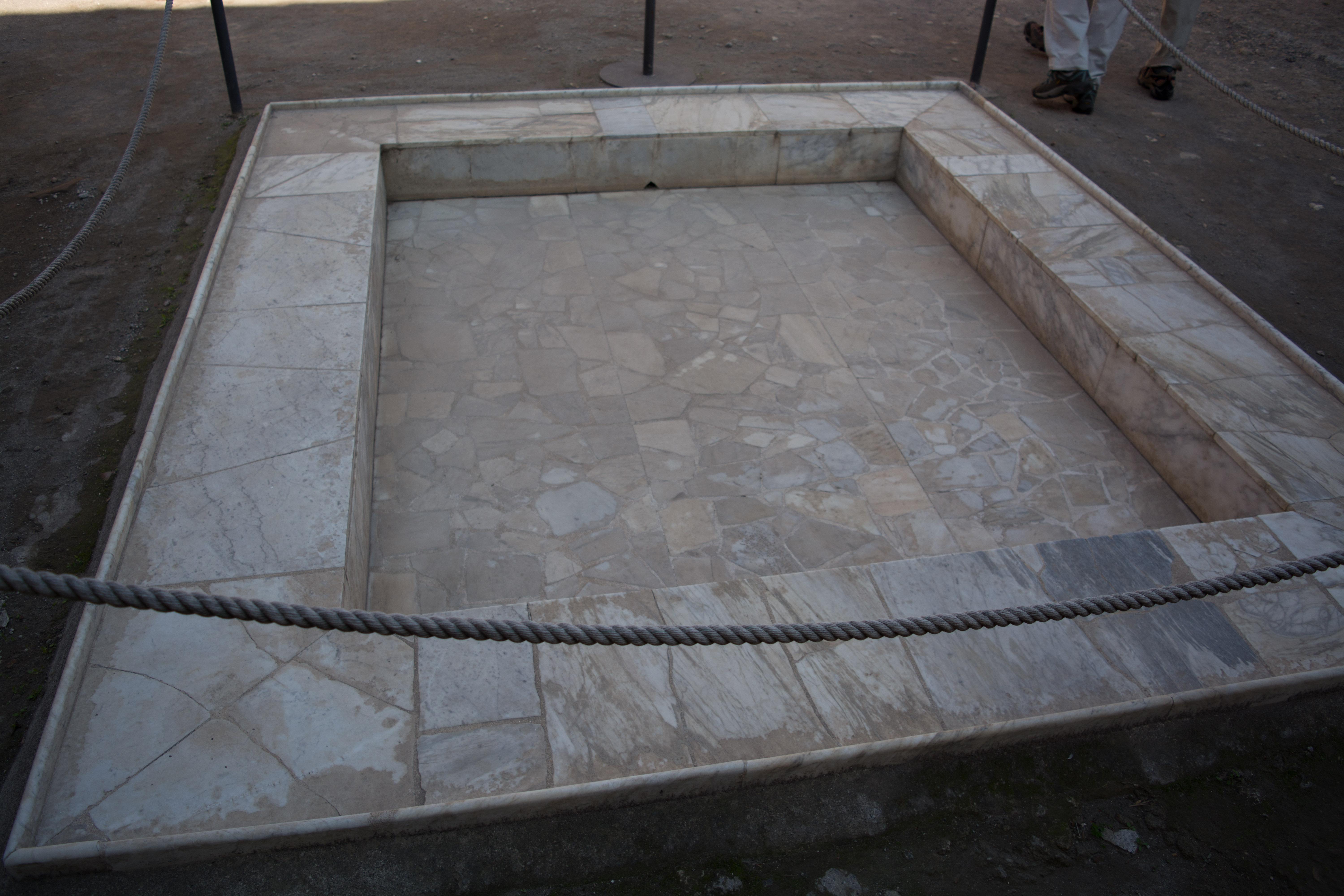
Nearby, another house has intact plaster over the doorway. A 2,000 year old wreath welcomes all who enter:
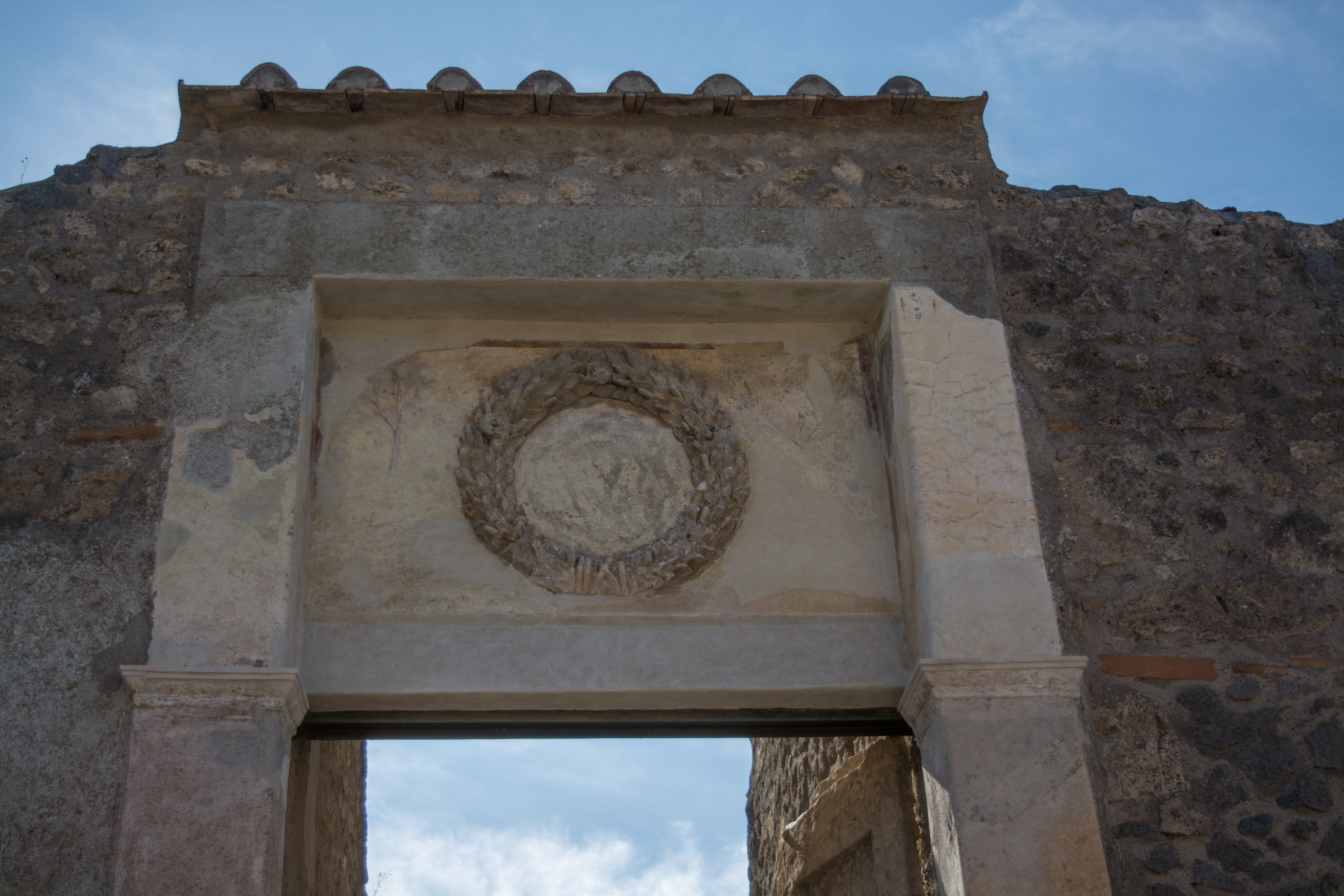
On the sidewalk in front of the house is a “hitching post,” a hole drilled through the stone where you would tie your horse (if you were rich) or your donkey (if you were poor) while visiting. This was very similar to the modern practice of parallel-parking your car:
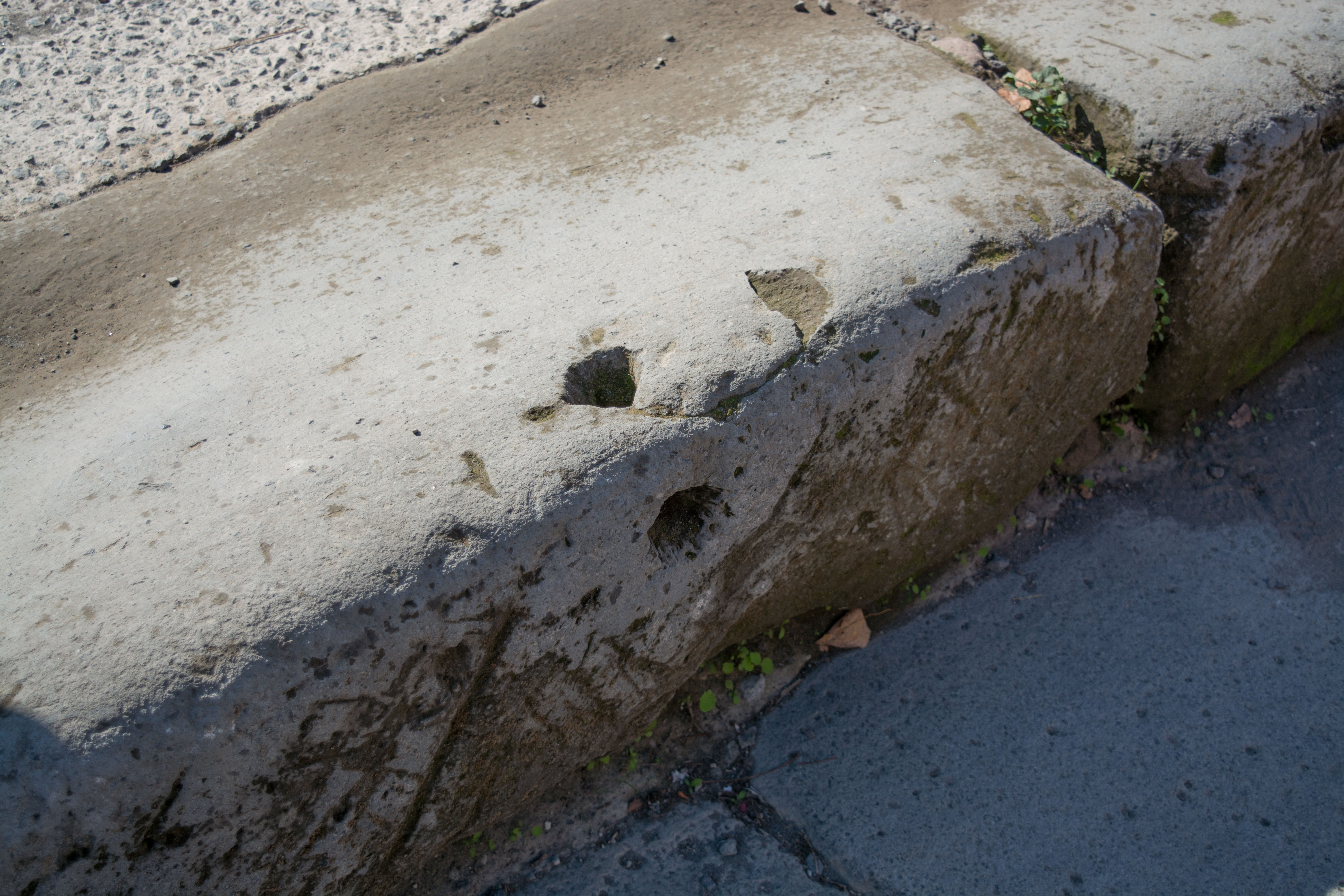
The door of this house has rotted away, but the same technique used to cast the bodies and the root systems was used to cast this door. The voids left by the wood became filled with plaster, but the nails are original and stayed in place. It makes it very easy to see how the door would have looked:
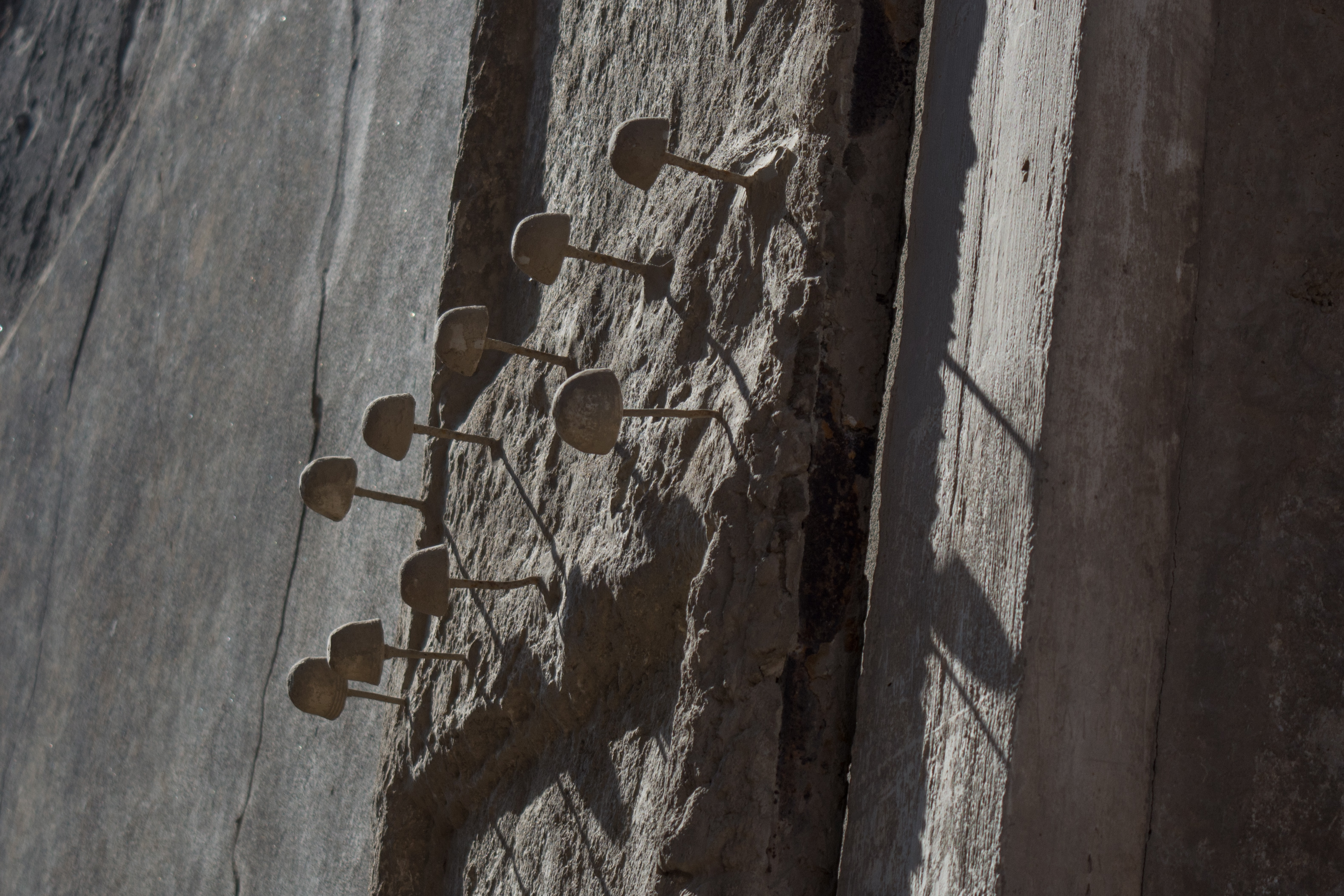
As we walk down the street we notice some red election graffiti. This is seen in many places in Pompeii, and these are basically “campaign signs” for the upcoming election. This larger one has several names and offices on it, and is likely a “party ticket” listing all of the candidates running for a certain political party:
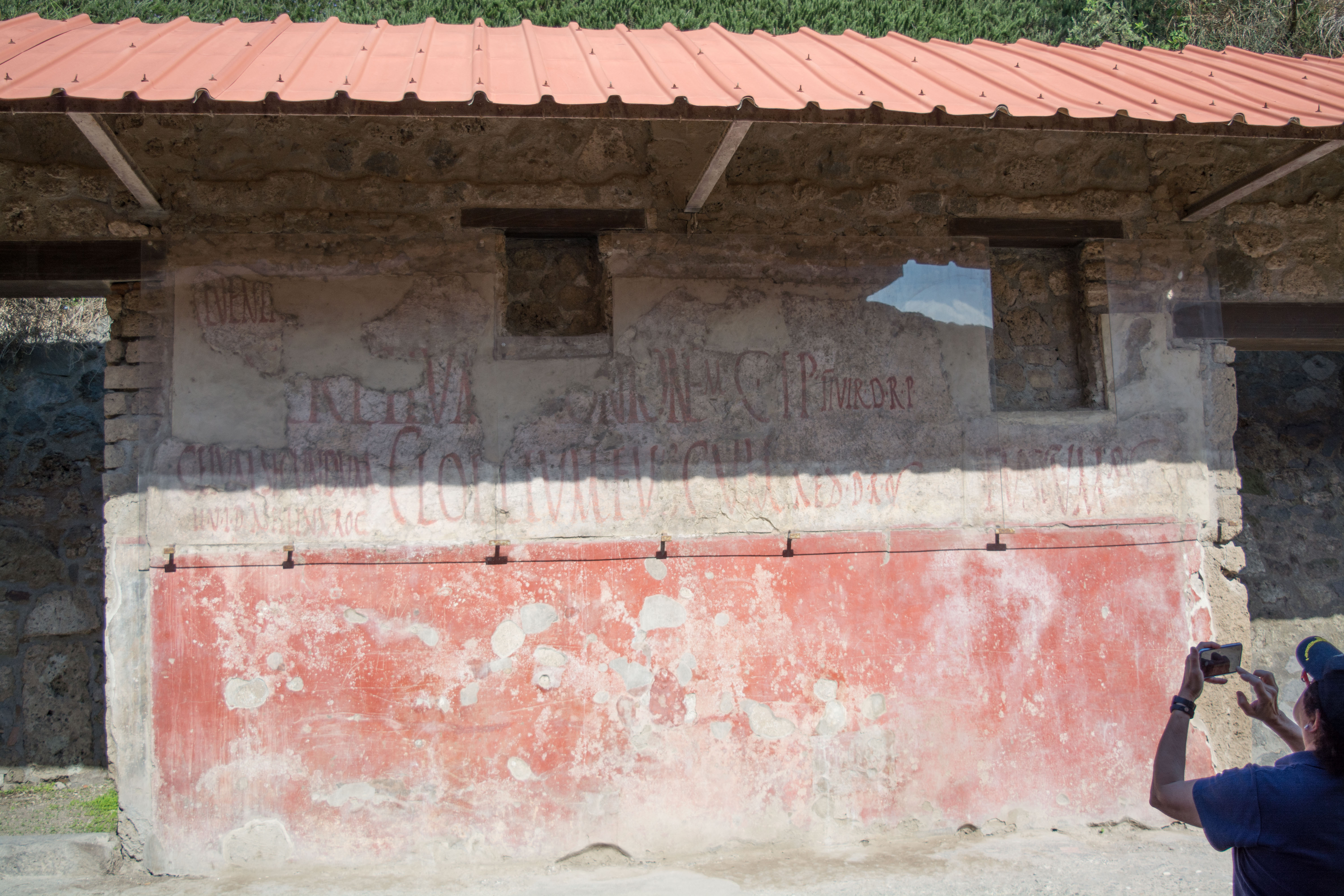
Some more election graffiti:
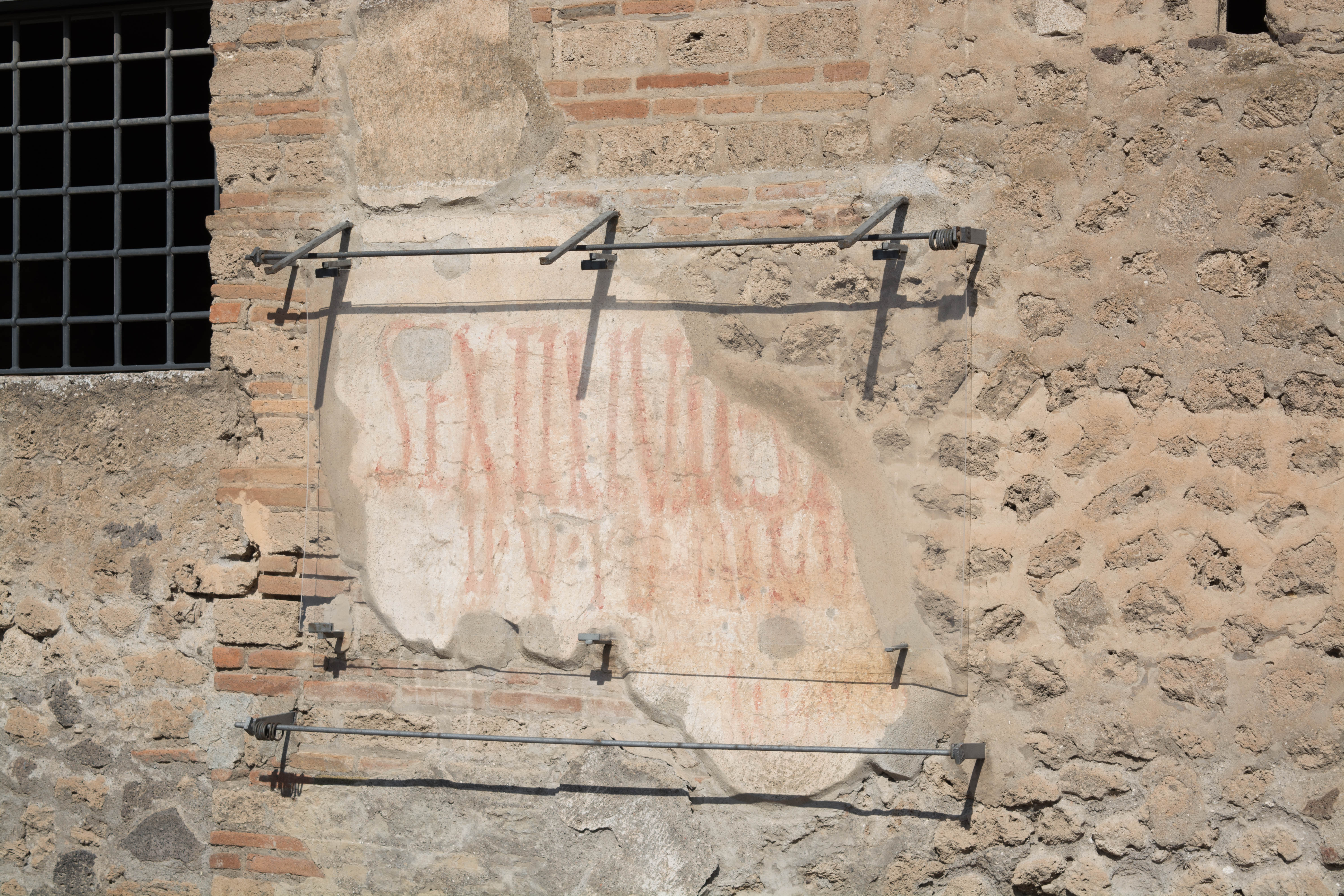
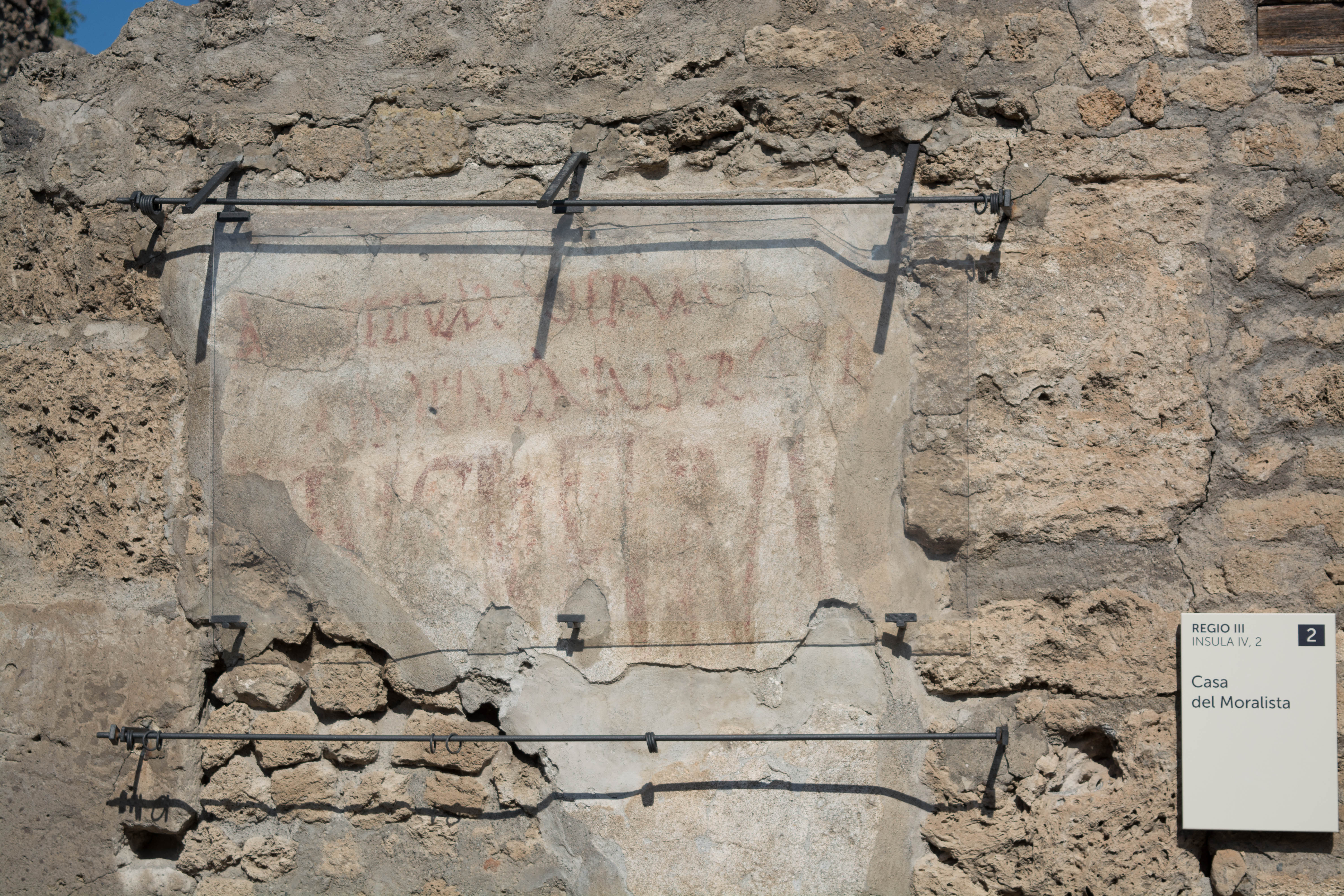
On this one “Satrium” is followed by the initials “OVI,” meaning, “Please Vote for Me!” The beginning of the word “Dedication” stretches out of the frame, proclaiming the candidate’s virtues for office:
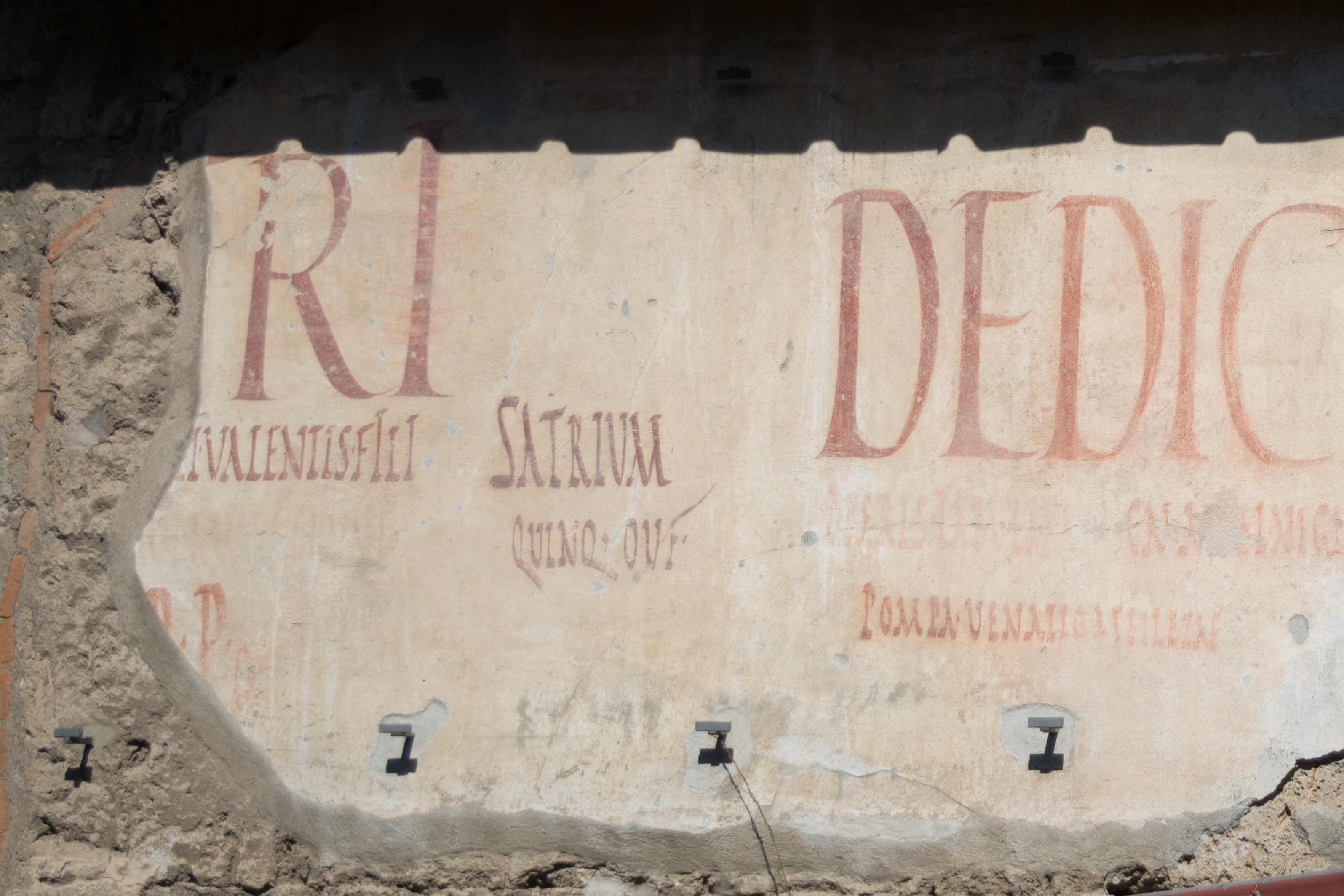
Several of the original water fountains around Pompeii have been restored to working condition. They have modern taps on them and visitors are welcome to use them to drink from or to refill a water bottle. The water is perfectly safe to drink. It was rather warm on the day we were visiting, so I refilled my water bottle from quite a few of these:
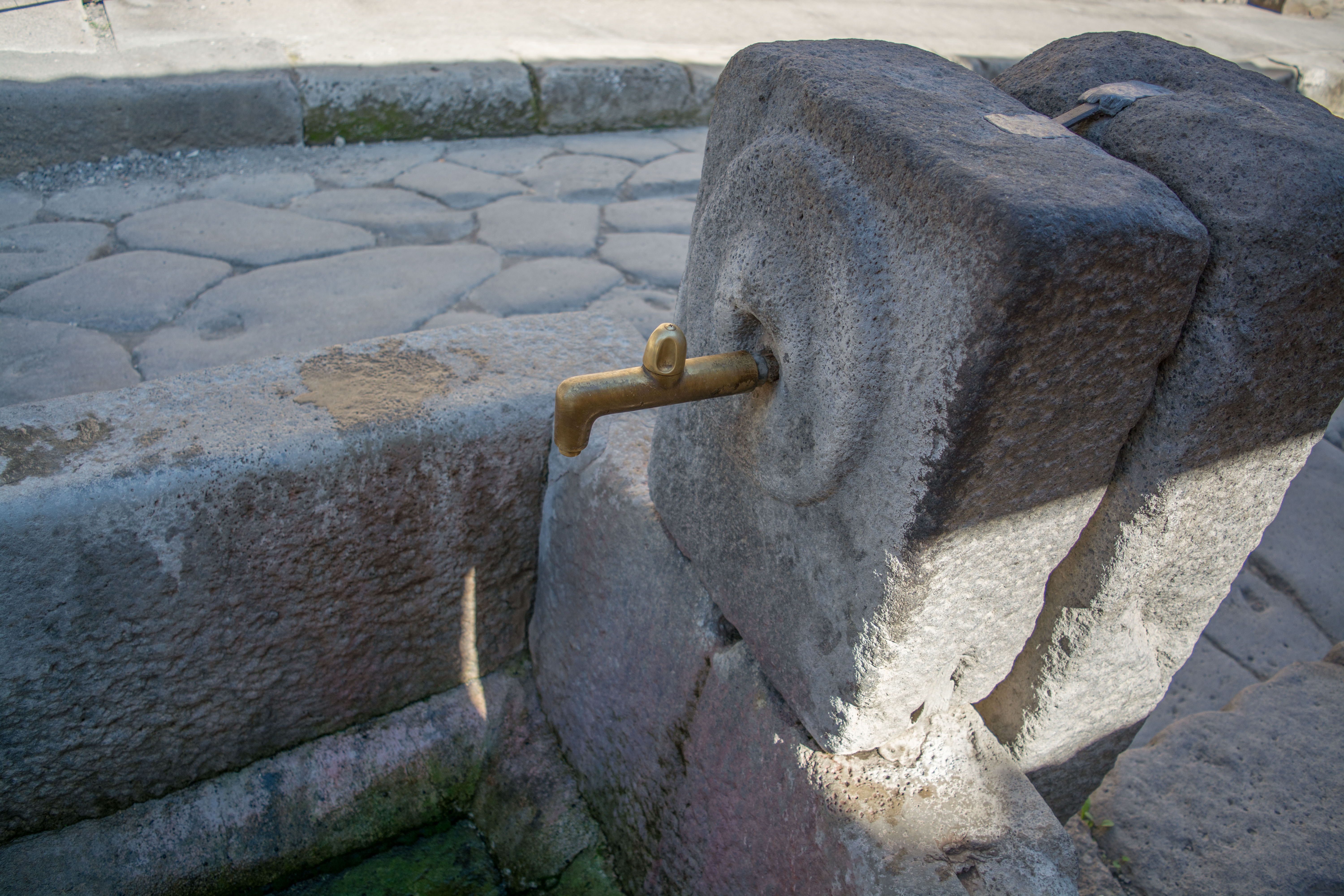
Walking further down Abundance Street, we pass a house where a proud dog owner has installed a mosaic of the family pet in the entrance:
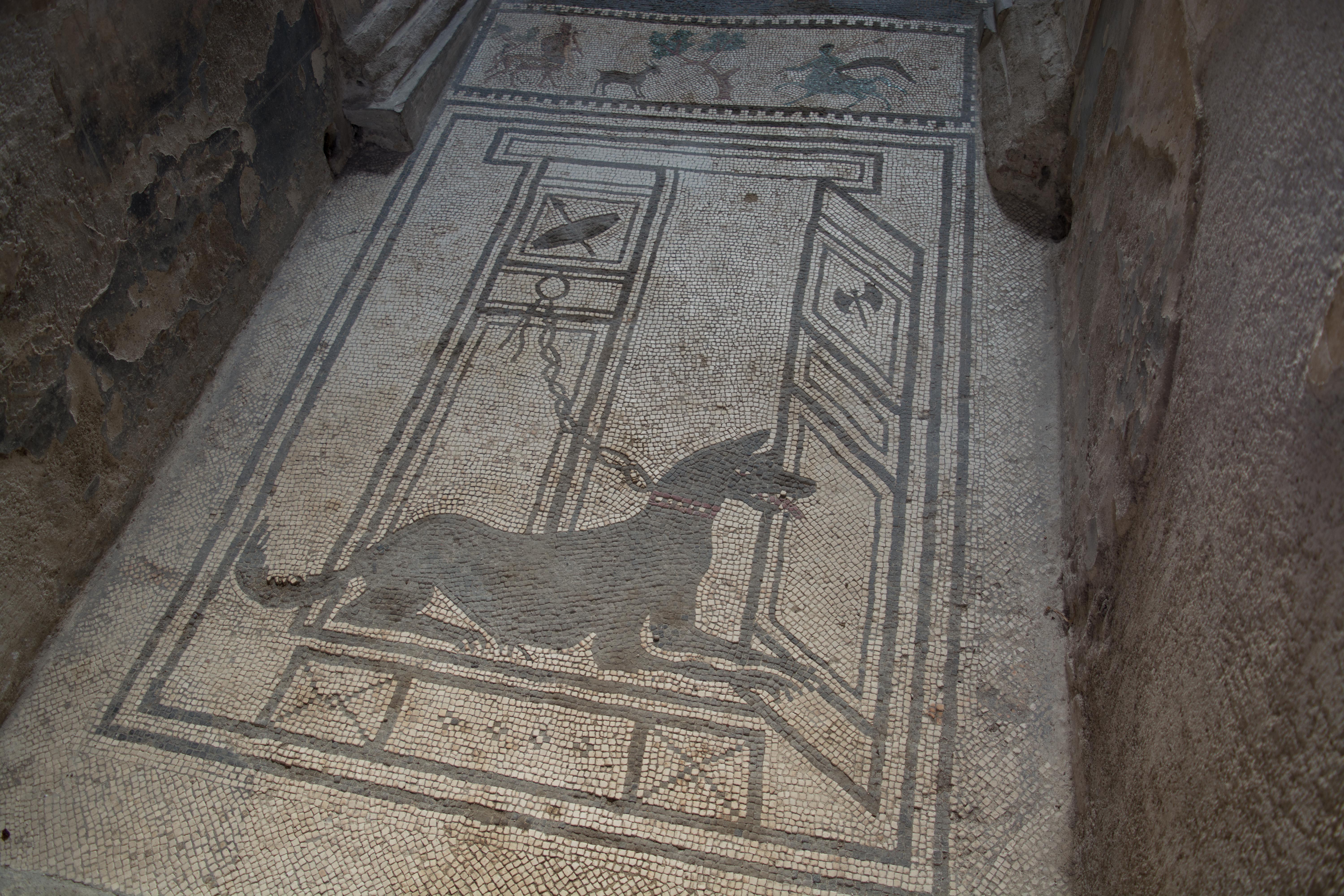
Then we went to the House of the Four Theaters, which has theatrical scenes on the walls. The blue pigment in the frescos is very rare for this particular time in history. It could only have come from either Egypt or Afghanistan. Importing it would surely have been very expensive. Simply by choosing this color the owner was making a statement on his tremendous wealth, and on the vast global reach of the Empire:
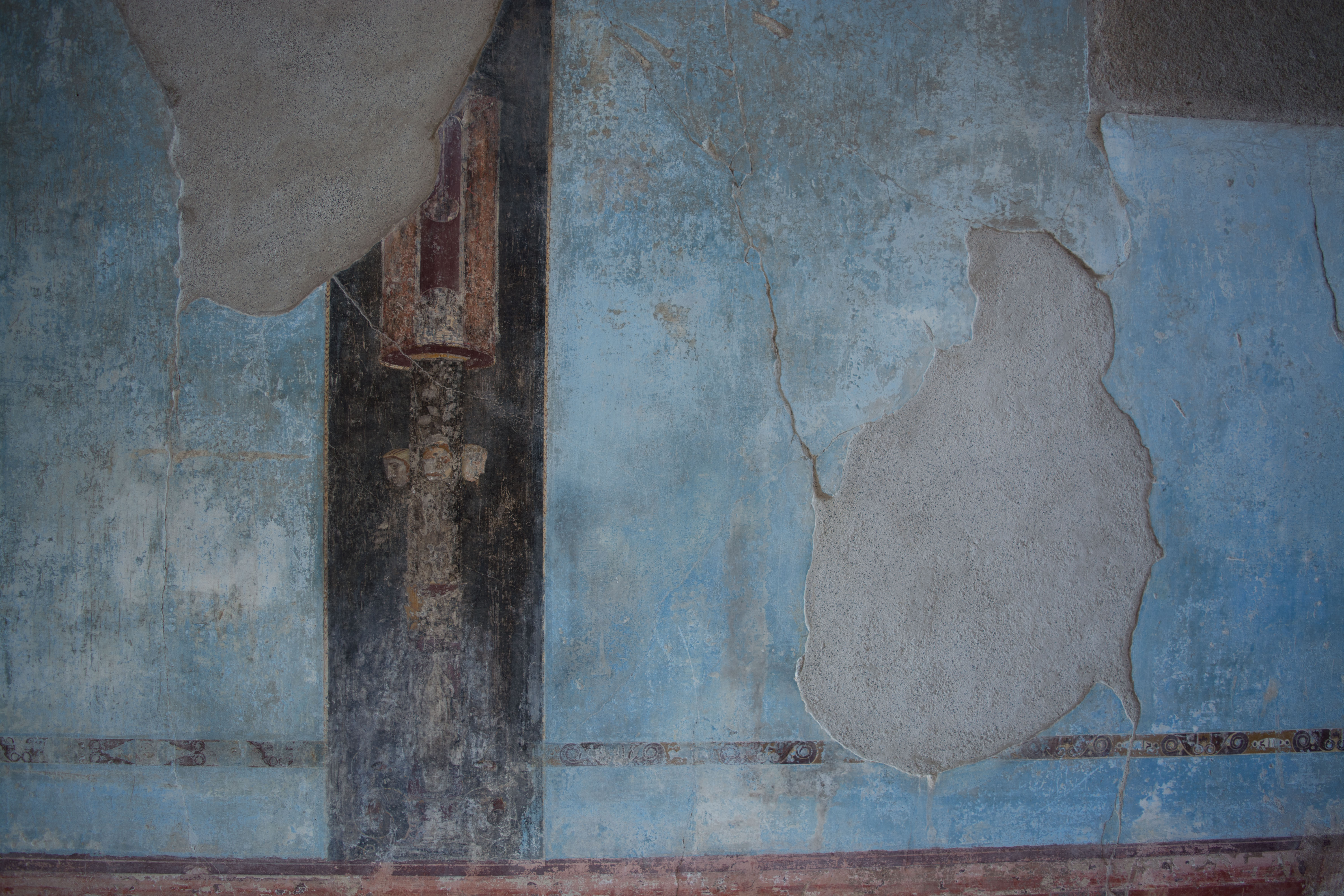
Another interesting item in this house is a table with a hidden inscription indicating that it once belonged to Publius Casca Longus, who was one of the co-conspirators in the assassination of Julius Caesar. Tony wondered aloud if the assassins might have sat around this very table, trying to decide who would stab Julius Caesar first. Here we see only the legs (which are original), the rest of it is in the Naples museum and will be shown in a later post:
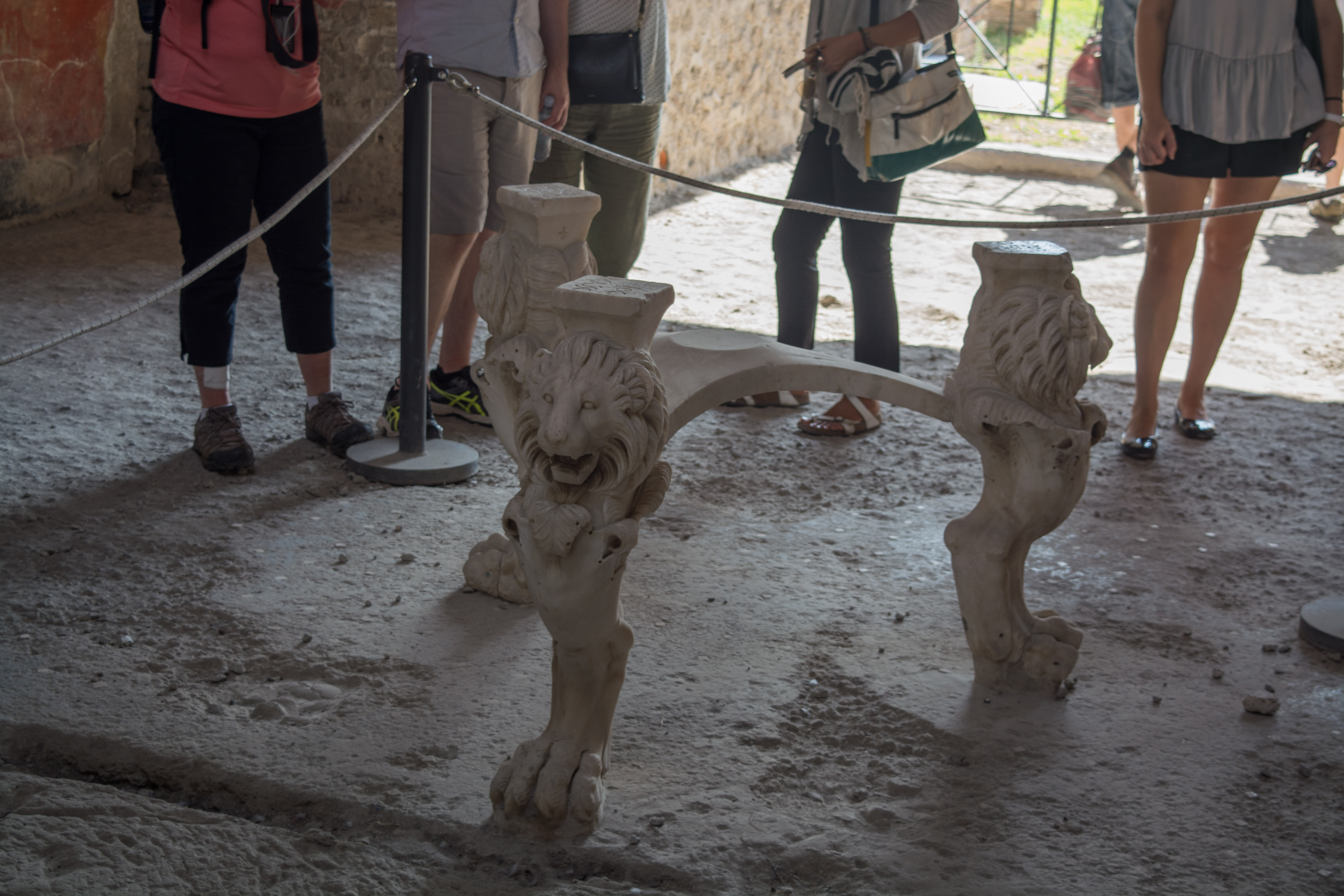
Next we went to the House of the Menander, which has plenty of still-intact plaster on the front. Election graffiti is easily identifiable to the right of the door:
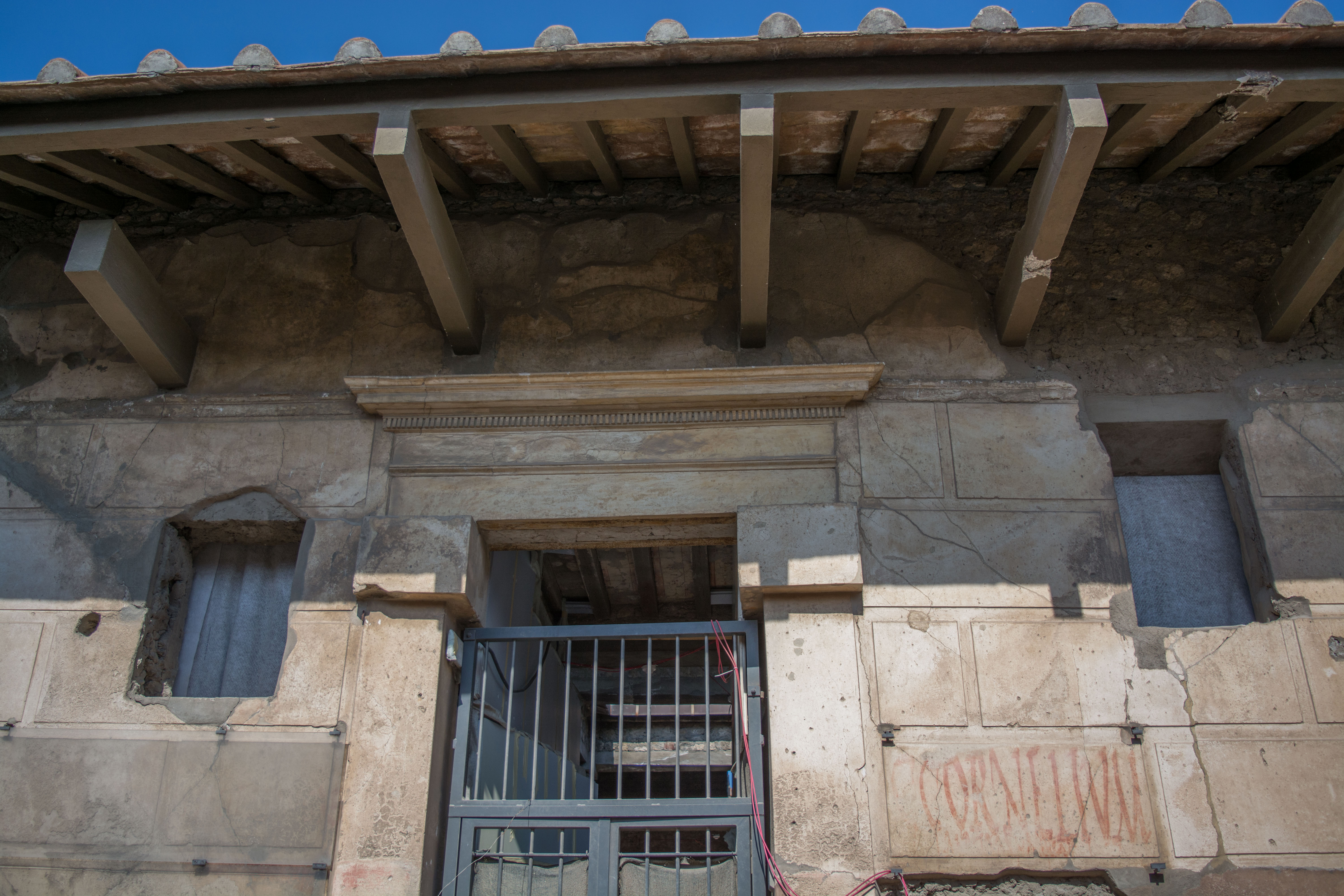
Inside is a small shrine to the household gods. These would have been very common in Roman homes:
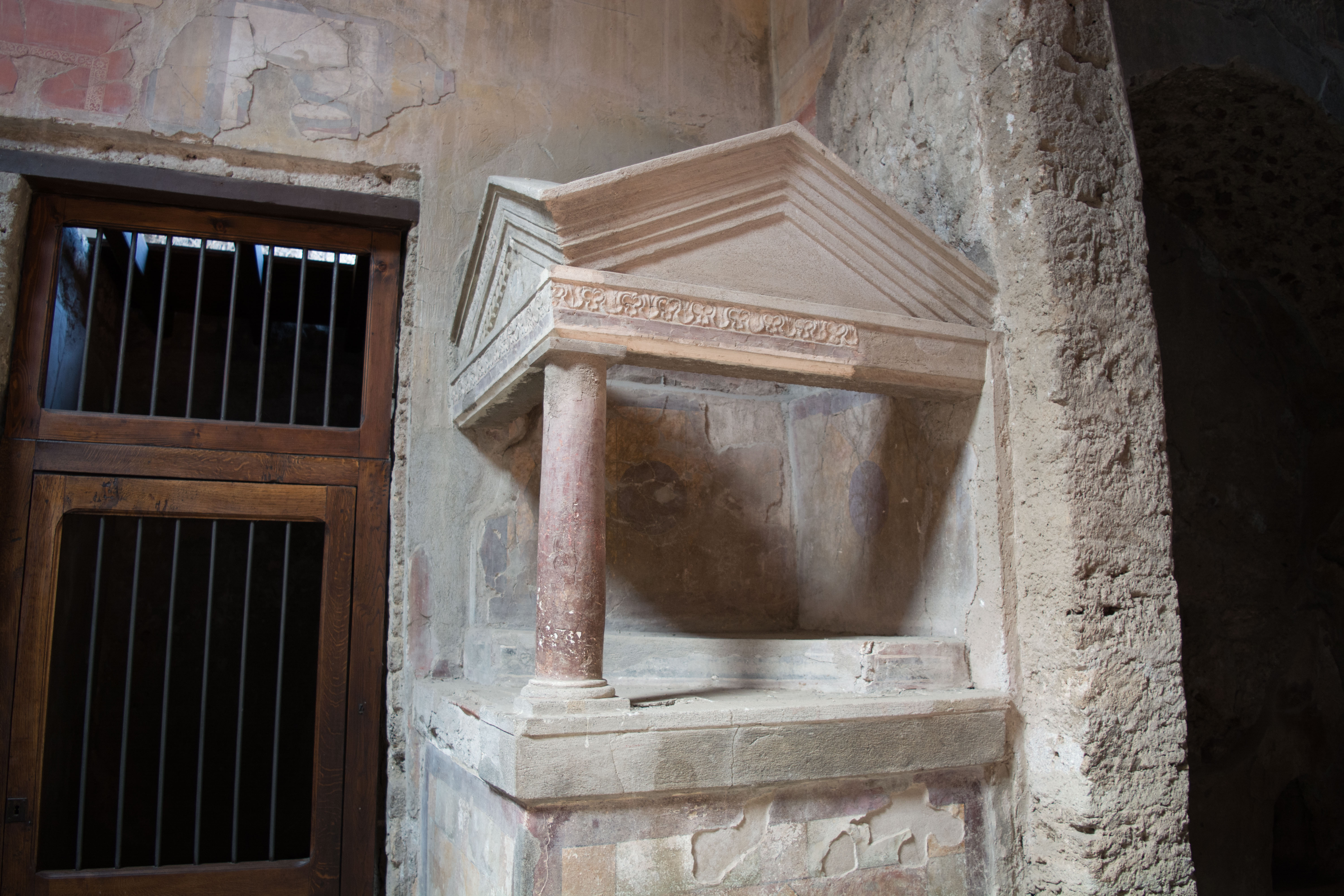
The marble impluvium is easy to spot:
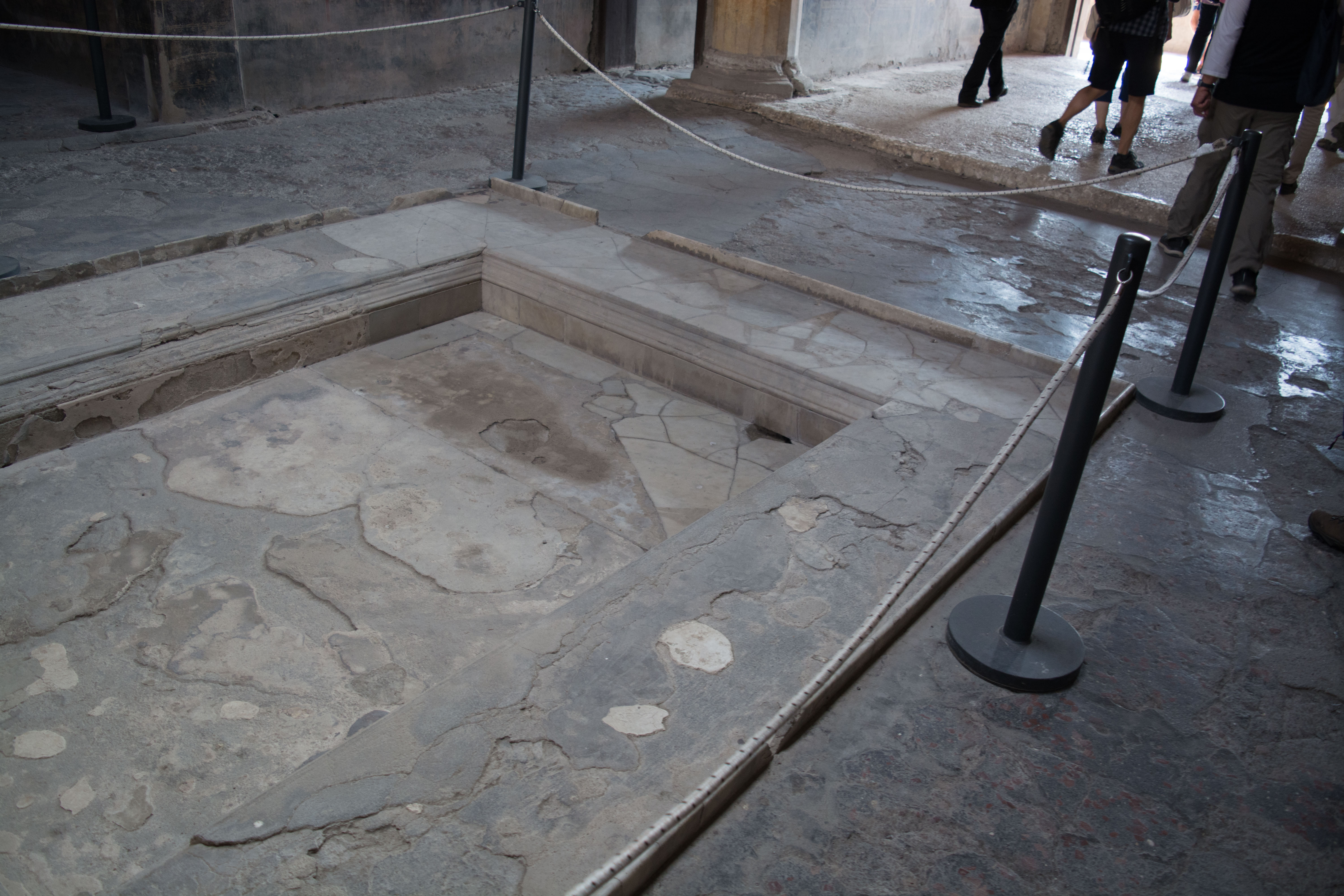
And the replanted garden, restored to its original appearance just like the others, is simply beautiful:
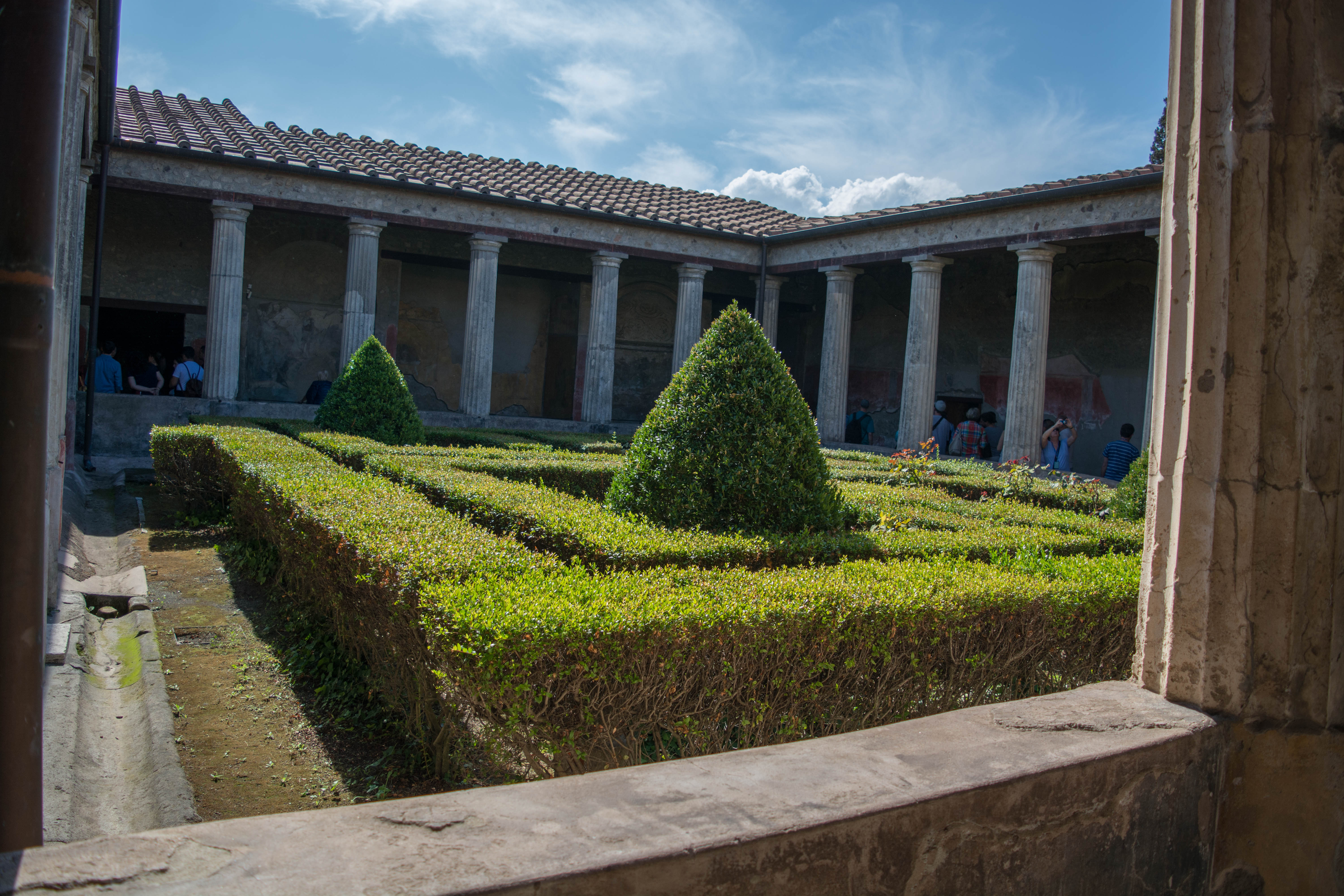
After the eruption several robbers broke into this house to try to steal any valuables that the owner might have left behind. Using picks and chisels they dug through the ash and pumice and broke a hole in the wall. They planned to then ransack the inside of the house for valuables. Unfortunately for them the ash had trapped toxic gasses inside the house, and once they broke through the wall they suffocated and died. Although encased in a glass box, their skeletons are still sitting where they died. The hole they broke in the wall has since been patched with concrete. They are very hard to see in the picture, but I was able to identify several of their tools lying next to them as well:
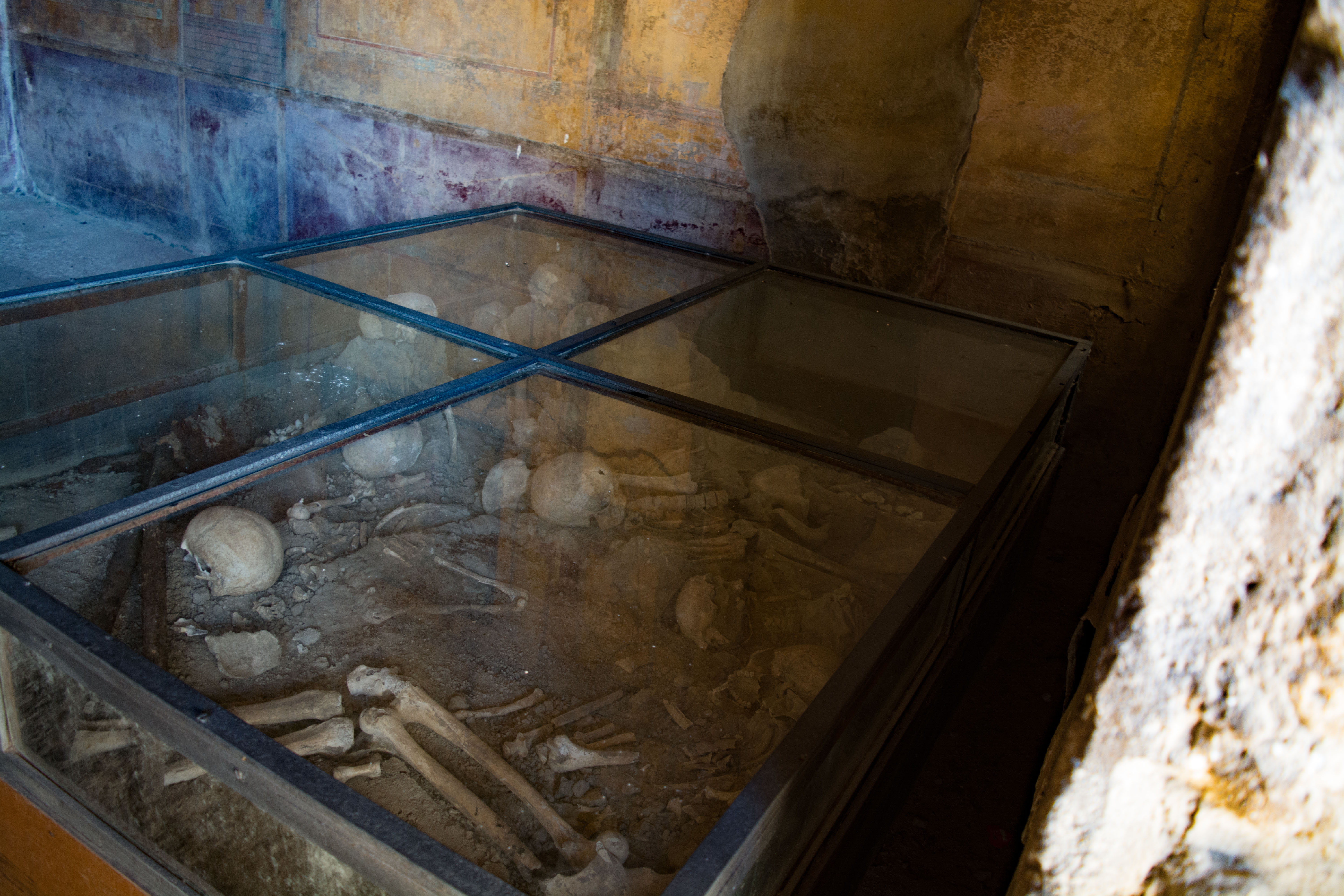
Even in Roman times children liked to draw on walls. Here a small child has drawn a hunting scene on the wall, which was not repaired before the eruption. It has been left exactly as it was found. I had to squat to get this photo because it was down on the child’s level:
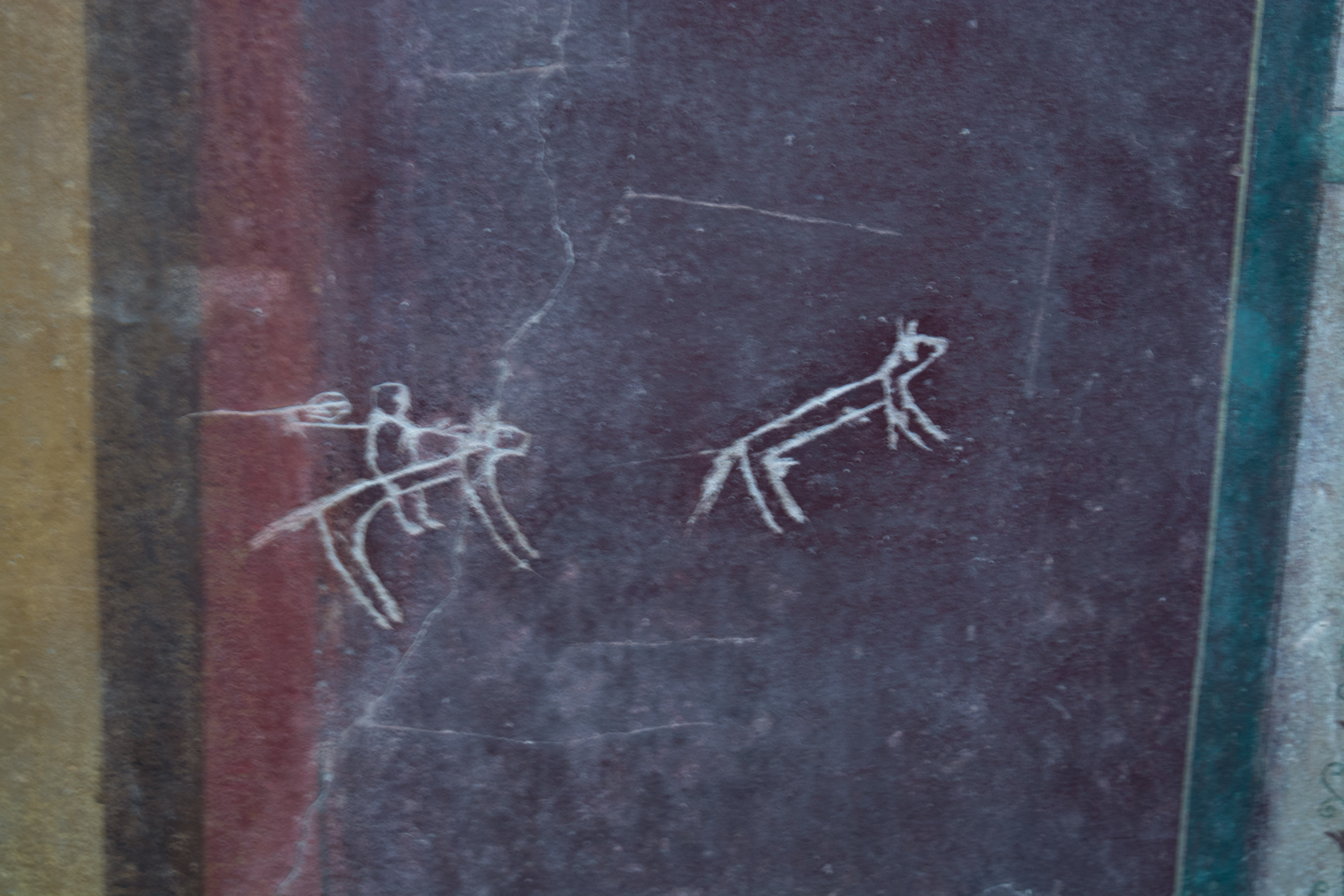
By now we are starting to make our way to the Forum, the large open area that was the social and economic hub of any Roman town. Along the way we pass the remains of one of the water towers. Tony explained that when it was in use, a lead pipe would have run through the groove in the center of the tower to a large tank on top. The Romans would have had 2 valves nearby, one controlling the connection from the Aqueduct to the tower and another controlling the connection from the tower to the homes and municipal water supply. When the tower was running low, the valve leading from the Aqueduct was opened (and the one leading to the houses was closed), causing water to flow into the tower under pressure. The pressure sent the water up the tower against gravity, filling the tank. Once the tank was full the valve from the Aqueduct was closed. It was then safe to open the valve leading to the houses, and in that way Romans could have cold running water in their homes. Those who were wealthy enough could have a bronze boiler installed in their home to provide hot running water as well. It was remarkably similar to our modern municipal water systems:
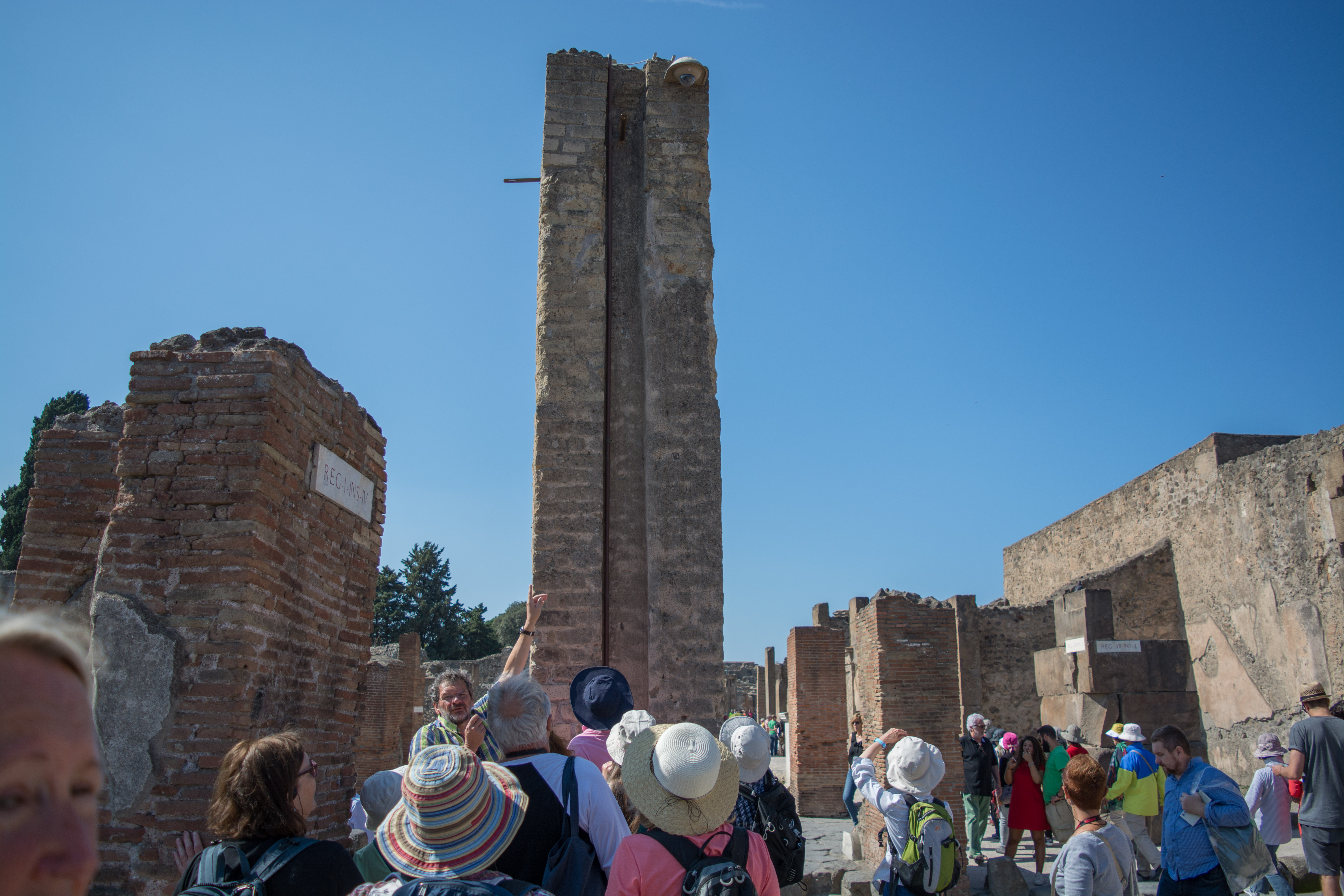
We can also see ruts in the street from many Roman carts:
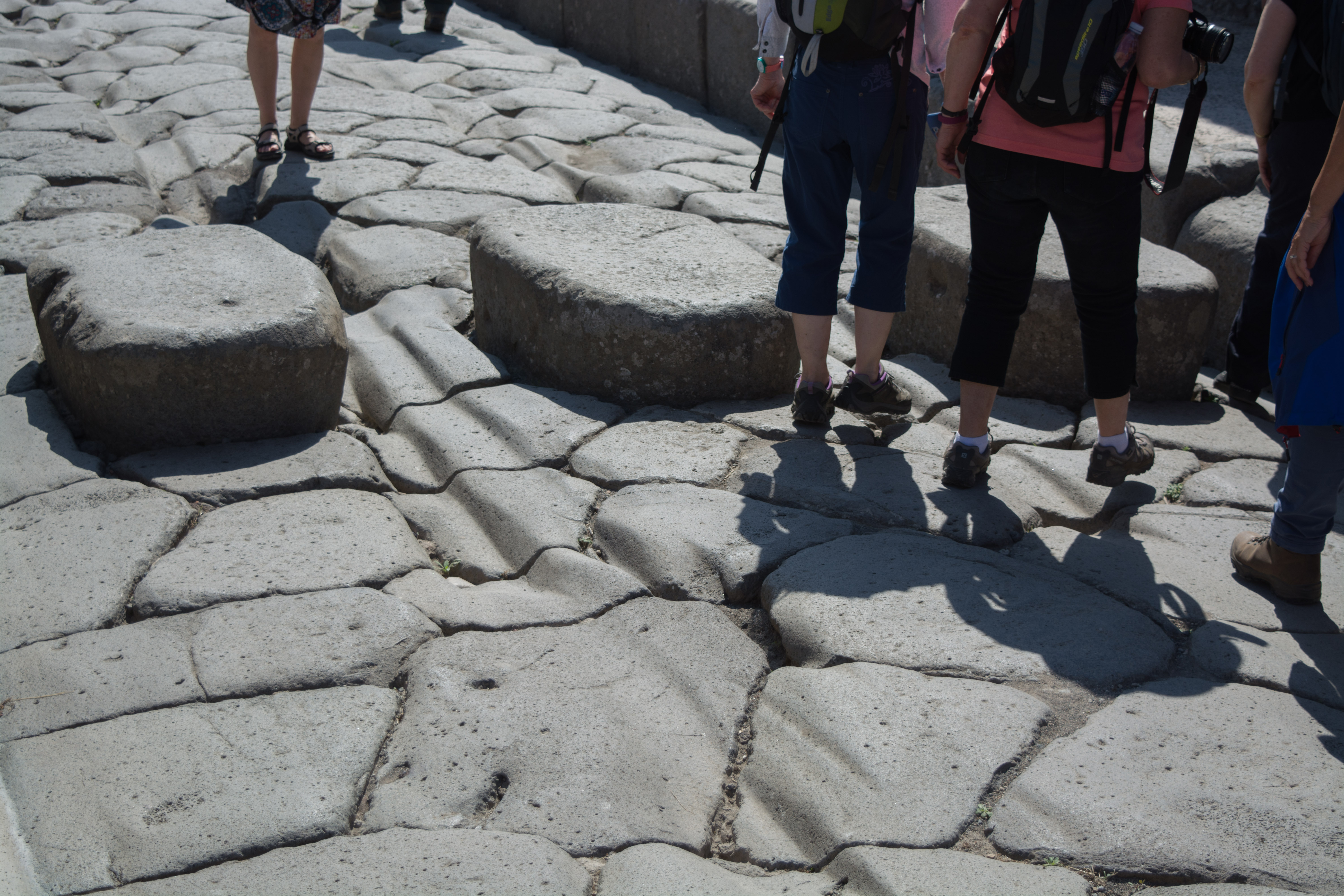
I’m going to stop here for Part 1. Next I’ll do a part 2, covering the rest of the things we saw in Pompeii on Day 3. Stay tuned!
